Rapport
Note to readers
Welcome to the fourth annual report on the global diamond industry prepared by the Antwerp World Diamond Centre (AWDC) and Bain & Company. Last year’s report, Journey through the Value Chain, focused on providing the investment community with a detailed understanding of the road to market for rough and polished diamonds.
In this year’s edition: Diamonds: Timeless Gems in A Changing World, we focus on key challenges facing the industry, initiatives under way to address them, and possible outcomes that would support the industry’s continued growth. We believe that the challenges explored in this report also present opportunities for all players in the diamond industry and for the investment community. The key challenges include the following:
- Sustaining demand for diamonds in jewelry and as investments. What models of cooperation are players adopting to spur demand for diamonds, in jewelry and as an investment vehicle?
- Securing long-term access to diamonds. As long-term supply tapers off, what options can retailers consider?
- Defining the role of synthetic diamonds. What opportunities and challenges will the continued evolution of synthetic-diamond technologies present to the industry?
- Ensuring that diamond financing will continue to sustain industry growth. How should the diamond-financing business model evolve to sustain healthy growth for all industry players?
As in previous years, the report also identifies key trends along the value chain for rough and polished diamonds as well as diamond jewelry. We compare 2013 results with the results of previous years and highlight the impact of continuing economic uncertainty on the diamond market.
We also provide an update on the outlook for the diamond industry through 2024. The 2024 demand outlook is based on our extensive market analysis and research. The updated supply forecast is based on the latest developments among key diamond miners and the largest diamond mines worldwide.
Readers seeking a quick overview of the report’s conclusions will find a summary of key takeaways at the end of each chapter and in the conclusion of this report. Some of the most significant points we touch on in the report are as follows:
- A sustained rebound and positive market outlook in 2013, despite continued macroeconomic uncertainty. In 2013, the diamond industry grew across every link in the value chain, powered primarily by demand in the US and China. Uncertainty for the industry stems primarily from the macroeconomic environment, which will determine demand dynamics in the major diamond-consuming countries.
- New ways to sustain demand for diamonds in jewelry and as investments. Demand for jewelry is still the main driver of diamond demand. Diamond jewelry marketing has shifted from generic to retailer-supported branded advertising since 2000. Recent developments include closer cooperation among industry players and a sharper focus on emerging markets. Investment demand remains relatively low, despite diamonds’ attractiveness as an investment. The industry is supporting initiatives to spur the long-term growth of investment demand by enhancing price transparency and market liquidity.
- Strategies for securing access to gem-quality diamonds. Because diamond demand is expected to outpace future supply, retailers are increasingly looking for options to secure access to gem-quality diamonds. They are considering long-term contractual agreements and investments in upstream or midstream players to secure such access.
- Opportunities and challenges presented by synthetic diamonds. Synthetics create new opportunities in high-tech and industrial applications. As jewelry inputs, they can coexist with natural stones. There currently is no indication that consumer preferences are shifting from natural diamonds to synthetics, but synthetics can erode customer confidence if sold undisclosed. The two major industry initiatives aimed at mitigating this risk are the increased use of synthetics detection technologies and more frequent certification.
- The need to adjust the operating model of the diamond-financing business. Bank lending in the diamond-financing industry has played a vital role, but in the past few years access to liquidity has become more challenging for middle-market players. The diamond-financing model needs adjustment to once again fuel industry growth.
- The long-term projection is for demand growth to surpass supply growth. We expect the difference between the demand and the supply growth rates to be positive from 2014 through 2018 and to widen starting in 2019. Demand is projected to continue its long-term growth trajectory, supply is projected to lag behind demand as existing mines will get depleted, and no major additions are projected to come online.
We hope you will find the insights in this report useful and compelling, and we look forward to discussing them with you.
1. Recent developments in the diamond industry
1.1 Overview of key trends along the value chain
From the peaks to the depths and back again: such has been the course traced by the global diamond market since 2008. In 2013, however, the diamond market showed clear signs that its rollercoaster trajectory of recent years has moderated, and that it is now on a path of steady, sustainable growth across every step of the value chain.
In 2013, rough-diamond sales increased by 2%, even though four out of five major producers increased their revenues by 5–16%. According to Kimberley Process statistics, smaller producers reduced their output, which pulled down the aggregate sales total for the year.
The cutting and polishing segment of the diamond value chain reported a 4% rise in revenues, to about $22 billion. India’s share of those revenues increased at an even more robust rate, to more than 60%, confirming the country’s status as the center of the cutting and polishing industry.
China, for its part, solidified its position as the hub of diamond jewelry manufacturing, capturing most of the industry’s revenue growth in 2013. China, already the global leader in overall jewelry production, now claims a growing share of global diamond-jewelry manufacturing, while the shares of Europe and the US have continued to dwindle, as manufacturers there focus almost exclusively on pieces for the top end of the market.
Retail sales of diamond jewelry rose an estimated 3%, and Euromonitor, an emerging source for perspectives on diamond jewelry sales, confirmed an even more aggressive growth trend in the first half of 2014. Continued strong demand from China and a resurgence of demand in the US powered the rise of the retail segment. In both countries retail sales grew, in percentage terms, at a high-single-digit rate. And despite worries that the positive momentum would dissipate in the second half of 2014, reports from the September Hong Kong Jewellery & Gem Fair suggest that the crucial 2014 holiday selling season will be a positive one (see Figure 1.1.1).
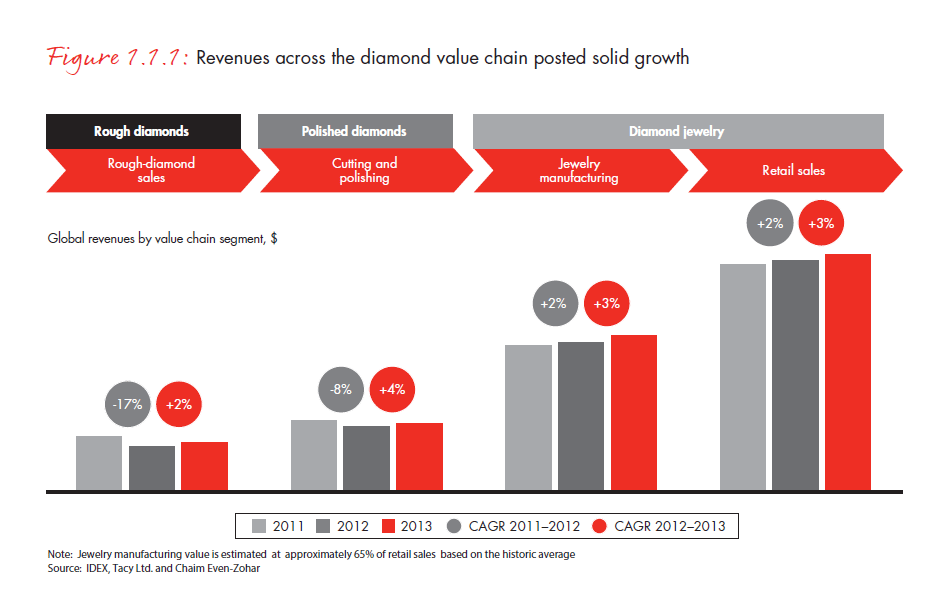
Prices of both rough and polished diamonds have corrected since peaking in 2011, showing a moderate growth trajectory in 2013 and the first half of 2014 that is in line with long-term historic trends (see Figure 1.1.2). Prices of different categories of polished diamonds grew at divergent rates, with prices for small stones growing faster than those for large stones. For example, prices of polished diamonds of 0.3 carats rose at a high single-digit rate, while stones of 1 carat and larger posted declines in the 3–4% range in 2013. Such disparity in price growth by category also continued in the first half of 2014, with prices for polished diamonds of less than 1 carat posting moderate growth in the 4–6% range and prices for larger stones continuing their slightly negative trajectory.
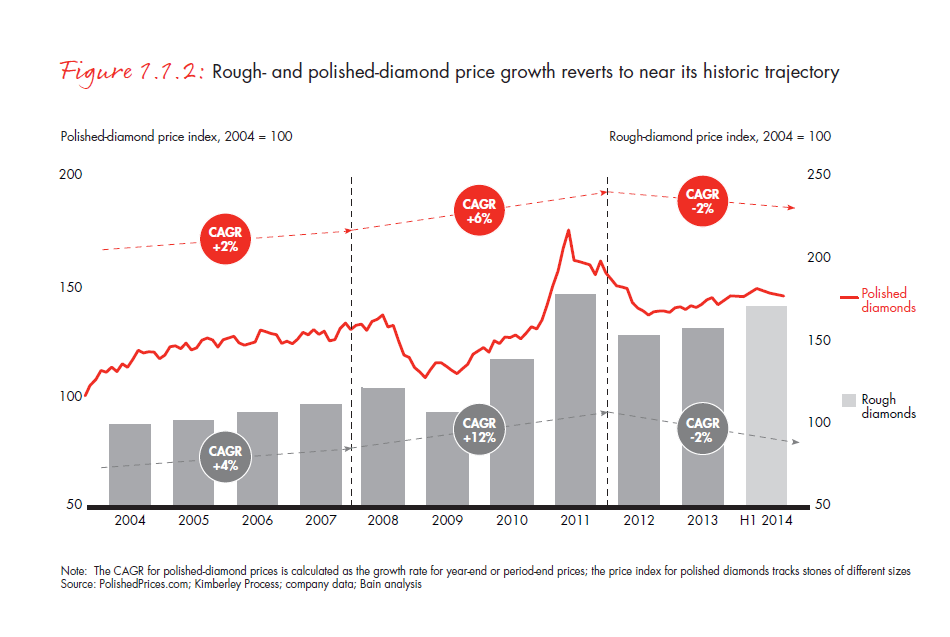
The US, China, and India remain the world’s three largest markets for diamond jewelry and power the global industry’s growth (see Figure 1.1.3). The US confirmed its position as the world’s leading diamond retail market, powered by economic growth of approximately 2% in 2013—a big improvement from the 1.6% decline posted during and immediately after the global financial crisis. The consensus forecast among economists is that the US is on pace for a period of steady long-term GDP growth in the 2–3% range, which suggests that US demand for diamond jewelry will continue to rise. Recently released short-term forecasts of US GDP are even more optimistic, with expectations of economic growth slightly above 3% in 2015.
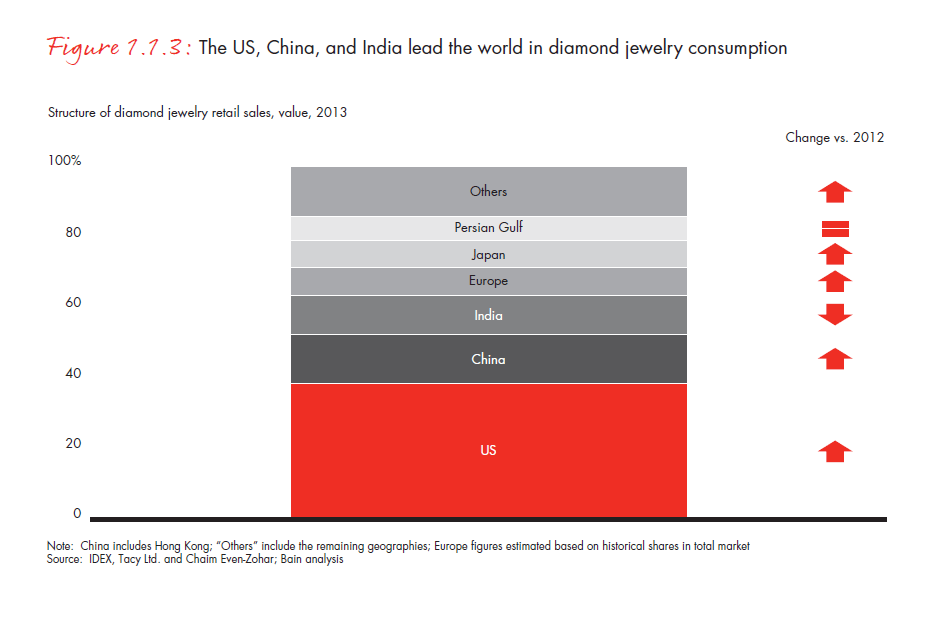
China is still the fastest-growing economy among the major global diamond jewelry markets, although its GDP growth rate has slowed somewhat from the mid-teens before the crisis to about 7.7% annually. In percentage terms, China’s diamond-jewelry retail sales in 2013 rose at a high-single-digit rate from 2012, a pace that seems sustainable going forward given the expectations for continuous robust growth of GDP and the middle-class population. That rate would preserve China’s status as the main engine of diamond-jewelry-industry growth.
Two other developments in China may have an impact on the demand for diamond jewelry. New anticorruption laws could have a short-term negative impact on the market for hard luxuries. At the same time, the Chinese retail market is coming to resemble mature, developed diamonds markets such as that of the US, according to industry participants. Diamond jewelry, once the exclusive preserve of China’s wealthiest citizens, is democratizing. Retailers are offering affordably priced jewelry containing smaller, lower-quality stones to meet increasing demand from the country’s fast-growing middle-class population.
Retail sales of diamond jewelry in India, the world’s third-leading diamond-jewelry market, fell despite positive GDP growth. There are several reasons for the downturn, including the 12% decline in the value of the rupee in 2013, a decline in gold prices of about 30%, and the nearly flat growth of the middle-class population since 2011. The rupee’s tumble eroded purchasing power, while the plunge in gold prices on the one hand made diamond jewelry cheaper owing to the effect on its gold component but on the other prompted consumers to substitute gold jewelry for diamond pieces. The rupee’s value has stabilized in 2014, and India’s economic fundamentals have improved—both positive indicators of improved diamond-jewelry retail sales in the near term and the basis for sustainable growth in the long term.
Demand in Europe, meanwhile, partially recovered. Conditions there require careful monitoring, however, because the European economy’s continued stagnation suggests that the GDP growth slowdown is not cyclical but has instead settled into a “new normal” of low or flat growth. Japan, the third pillar of the diamond jewelry market in the developed world, maintained moderate demand growth despite increasing tax pressures that affected luxury- goods sales in 2013 (see Figure 1.1.4).
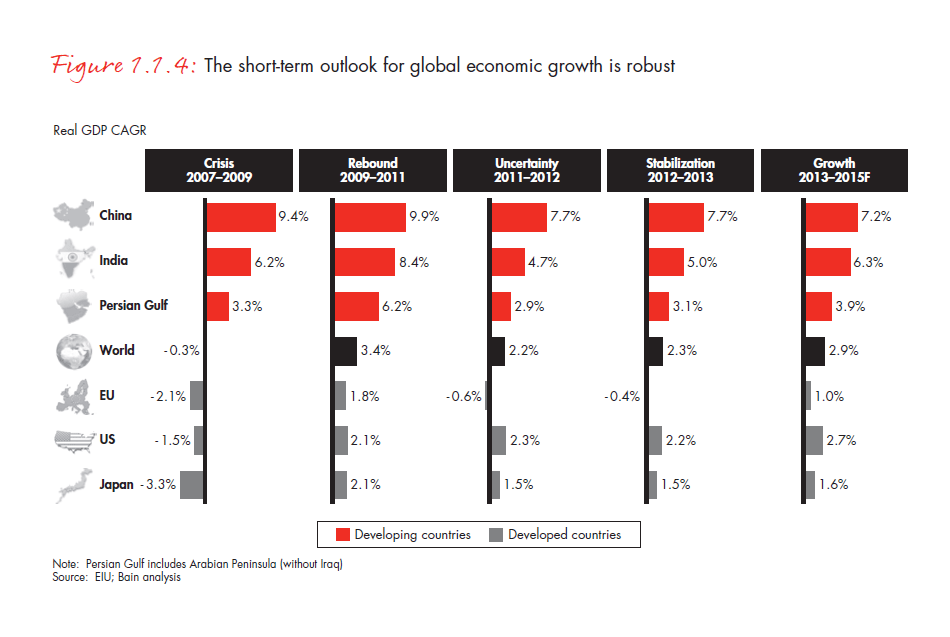
The diamond industry’s total profit pool remained stable in 2013. Diamond jewelry retail claimed the largest share of the industry’s profit pool—slightly less than half. Retailer margins were stable overall but varied significantly among players: from 20–35% for luxury players down to the low single digits for online retailers or smaller shops. Mining accounts for the next-largest share, claiming about a quarter of the total pool, with profit margins of 21–25%. The increase in mining profits is attributable to increased production at most large mines, higher rough-diamond revenue generated by changes in diamond production mix and price, and operational improvements.
Cutting and polishing margins tell a somewhat different story. Although operating margins for cutters and polishers and traders held steady in the 1–4% range, margins were more widely dispersed than in previous years. Smaller players, facing growing costs for labor, real estate, and energy, saw their margins shrink to zero or turn negative. Some larger players, by contrast, were able to improve operating effectiveness and take advantage of trends in polished-diamond prices to post margins as high as 10%. Most of those players were large integrated companies whose operations run the length of the middle-market value chain, from polishing to jewelry manufacturing (see Figure 1.1.5).
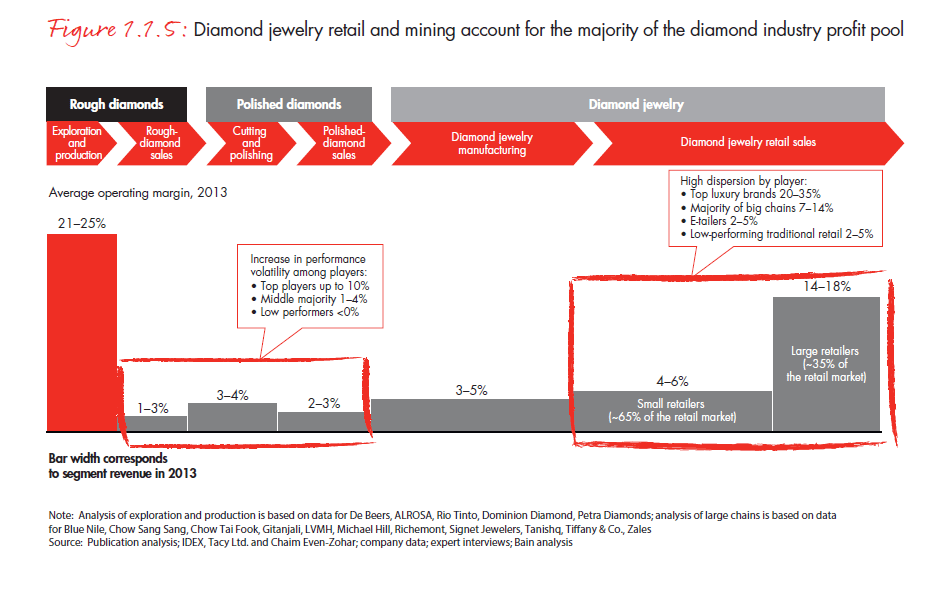
1.2 Rough-diamond production
In 2013, according to Kimberley Process statistics, rough-diamond output, as measured by carats, grew a modest 2% to 130 million carats. Output in 2012, for comparison, increased more, by 4%.
Russia claimed the largest share of the production increase—3 million carats. Production rose because ALROSA’s Aikhal underground mine reached its target capacity, ore grade at the Jubilee pipe improved, and ALROSA acquired the Nizhne-Lenskoye diamond-mining company. Australia’s production increased 2.5 million carats as a result of Rio Tinto’s commissioning of an underground mine at Argyle. Botswana’s output grew by 2.5 million carats because of increased production by Debswana.
At the other end of the production spectrum, the Democratic Republic of the Congo and Zimbabwe cut their production by a combined 7.4 million carats. Congo reported that production decreased by 5.8 million carats, but industry insiders suspect that output might be understated. Zimbabwe’s production fell by 1.6 million carats. Alluvial deposits have been depleted, and producers have been slow to transition to more costly underground mining (see Figure 1.2.1).
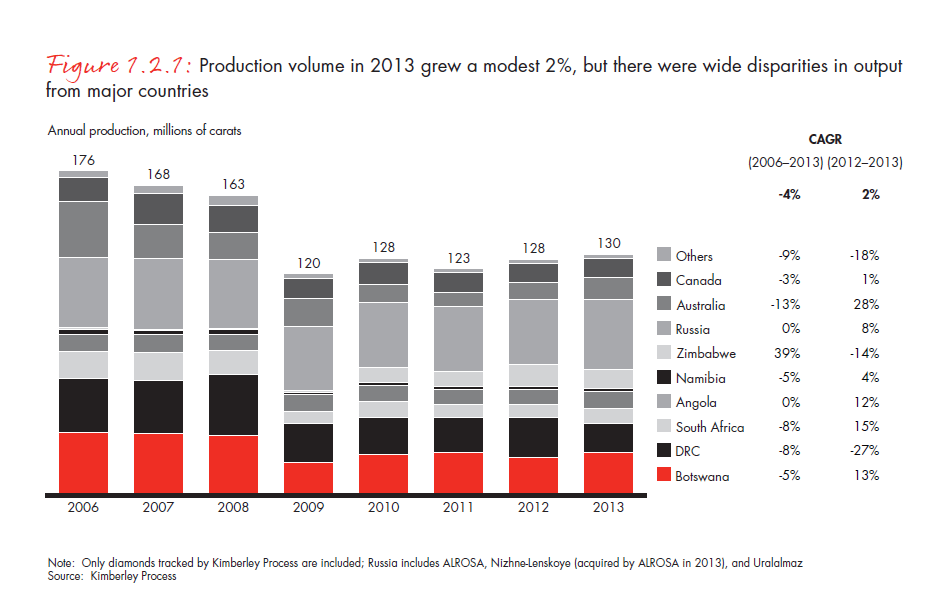
Even though overall growth was moderate, all five major rough-diamond-producing companies increased their output in 2013, three of them by double-digit percentages. ALROSA, which produced 37 million carats, a 7% increase from 2012, was once again the volume leader (see Figure 1.2.2).
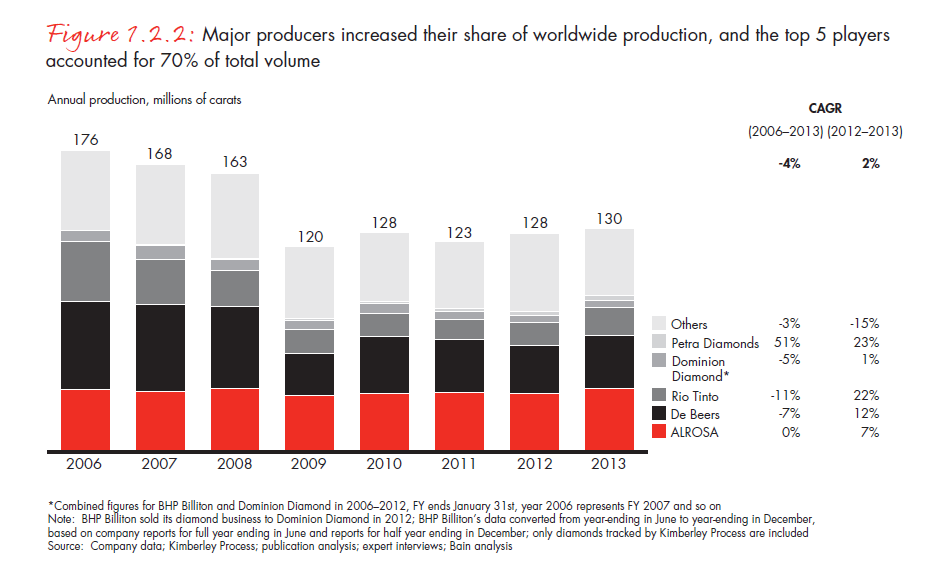
De Beers, whose sales increased 5%, retained its position as the revenue leader, followed closely by ALROSA. The top five players together collected about 85% of industry revenues, with Petra Diamonds posting the largest revenue increase in percentage terms, 16%. Rio Tinto’s revenues increased 15%, as underground operations in the Argyle mine came online. ALROSA’s revenues rose 9%, consistent with its increase in production volume (see Figure 1.2.3.).
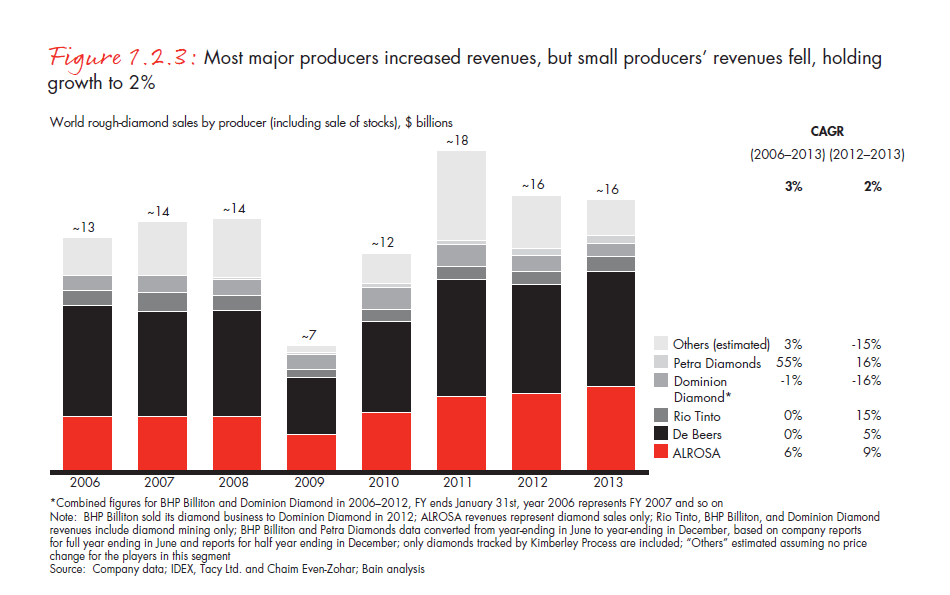
In the first half of 2014, the dynamics of production among the major producers changed. ALROSA’s output decreased by 7% compared with the first half of 2013 because of planned maintenance at the Aikhal and Udachnaya processing plants and despite the growth of output from recently launched Severalmaz production. The pace of growth at Rio Tinto and Petra Diamonds slowed from the double digits to 2% and 4%, respectively. Dominion Diamond ramped up its output by 7%. De Beers sustained its pace of growth at 12%, thanks to higher output at Venetia following the recovery from a flood in the pit and higher output from processing plants at Jwaneng.
Three other events in 2014 are worth noting. LUKOIL started diamond production in its Vladimir Grib mine, selling the first diamonds at auction in Belgium. ALROSA commissioned its Udachny underground mine, and Charles E. “Chuck” Fipke, a legendary diamond explorer, agreed to sell his remaining 10% stake in the Ekati mine to Dominion Diamond.
Profitability
Revenue growth and higher prices for rough diamonds translated into improved profitability for all major producers in 2013, as measured both in absolute terms and by price per carat.
ALROSA remained the leader in absolute earnings before interest and taxes (EBIT), followed by De Beers. ALROSA recorded EBIT of $1.8 billion in 2013, delivering a strong growth on the heels of its successful IPO earlier in the year; De Beers reported EBIT of $1 billion. Measured by EBIT per carat, ALROSA leads the way, followed by Petra Diamonds and De Beers. While Rio Tinto and Dominion Diamond trail the top three by a considerable margin, both have recovered from losses in 2012 and are steadily improving their profitability (see Figure 1.2.4).
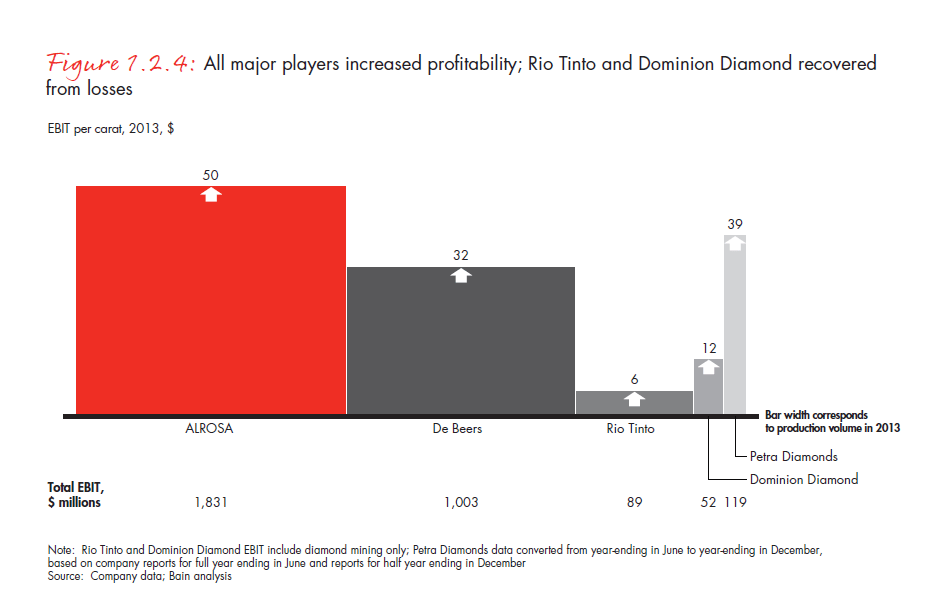
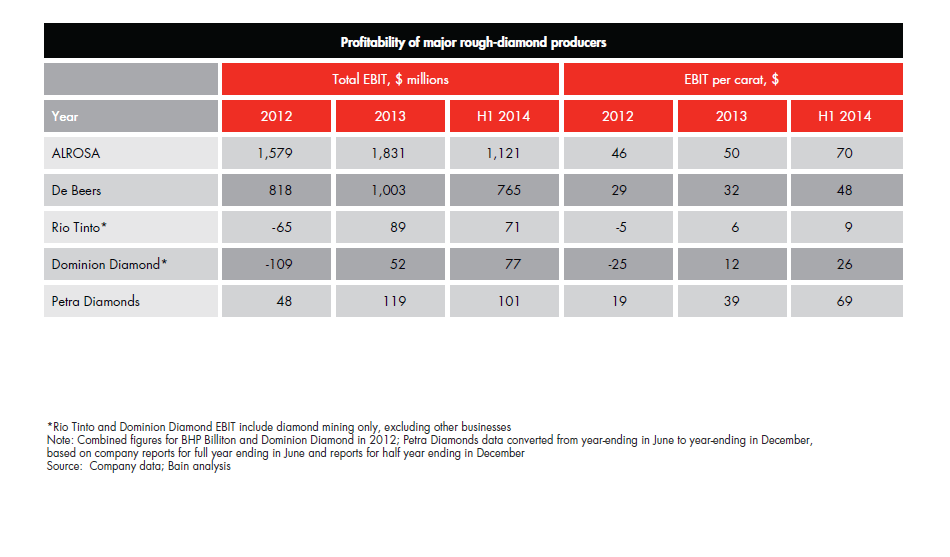
The trend of increasing profitability continued into the first half of 2014 (see Figure 1.2.5).
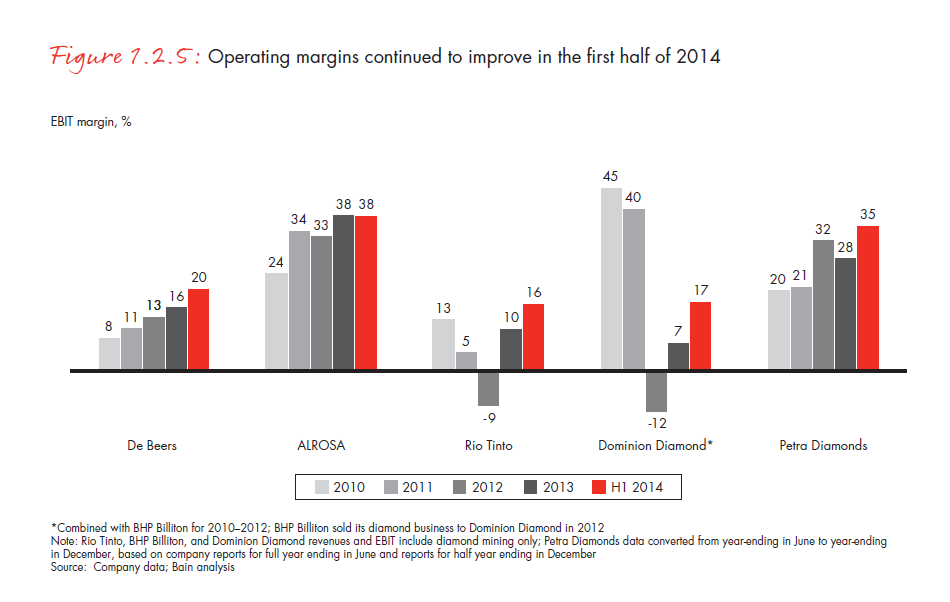
Key challenges
Today’s diamond market presents producers with four major challenges:
- Reserves replenishment
- Environmental challenges
- Increasing social awareness
- Increasing pressures on operating costs
Reserves replenishment
There are few known major underdeveloped diamond sites, and no major discoveries have been made over the past two decades. As a result, the cost of finding new, economically recoverable deposits is rising.
Environmental challenges
Increasing public awareness of environmental topics has had direct impacts on the mining business. Producers are under pressure to make effective use of energy and reduce emissions. They must also focus on waste management to increase recycling and control water consumption, a task complicated by the fact that most important production sites are located in water-scarce areas. And mining’s impact on biodiversity and ecosystems in general is an issue.
Social awareness
Producers are paying increasing attention to local communities in areas of production, resulting in direct and indirect impacts on output. Beneficiation programs are meant to support economic development and boost employment in diamond-producing countries by setting up local cutting and polishing operations. Such businesses were set up in Africa in recent years, and there is a discussion of developing a Russian cutting and polishing industry under ALROSA’s leadership. Indirect impacts are visible in producers’ involvement in local communities outside their core mining activities. This involvement often takes the form of financing or developing social infrastructure in mining areas.
Increasing pressure on operating costs
Consistent with the mining industry as a whole, diamond producers are facing rising costs for inputs such as labor and energy, as well as projects whose increasing technical challenges translate to higher operating costs.
Confronting mounting challenges that are not unique to the diamond industry but rather representative of the entire mining sector, producers must make significant investments in new technology and operating efficiency to sustain the diamond mining industry in the medium and long term.
1.3. Cutting and polishing
The cutting and polishing market swung back to positive growth in 2013 after receding in 2012, with revenues increasing to approximately $22 billion, a 4% rise. That growth was confined to India, which solidified its position at the heart of the cutting and polishing industry with a 12% revenue increase. India now claims more than 60% of the cutting and polishing market (see Figure 1.3.1).
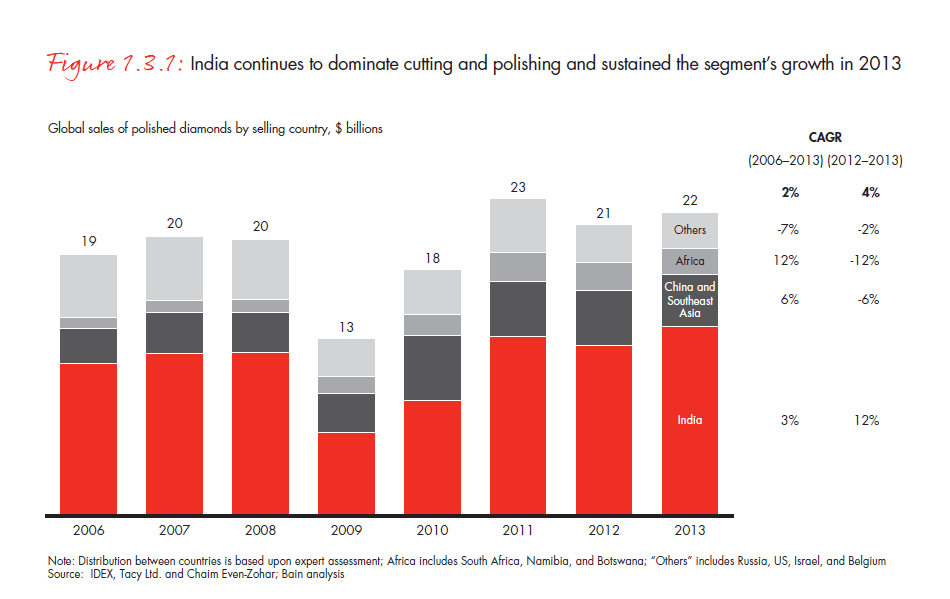
India delivered growth even as China, another major cutting and polishing region, saw its market share reverse its growth trajectory and decline by 6%. Two major factors contributed to India’s outperformance. Technological innovations and increased operating efficiency propelled India into a clear position of cost leadership and drew rough-diamond volumes away from China. And Indian banks continued to sustain the industry’s liquidity despite tightening their lending standards, while decreased financing availability forced players in other markets—most notably Europe, Israel, and the US—to deleverage.
China’s cutting and polishing costs for small diamonds are higher than India’s, and China also lacks India’s range of viable financing options. Unlike India, mainland China has not yet developed a network of local players to support local cutters and polishers. Yet the market shares of China and Southeast Asia could have decreased even further were it not for several mitigating factors. The growth of local jewelry manufacturers that seek direct control of process efficiencies and detection of synthetic stones has prevented more volumes from migrating to India. In addition, social pressures have persuaded manufacturers to keep some polishing operations near manufacturing sites.
A number of key downstream players have decided to retain some production capacity in Southeast Asia, and some have even enlarged their footprint. Tiffany & Co., for example, opened a new polishing facility in Cambodia in 2013.
Belgium, Israel, and the US, whose cutting and polishing industries concentrate almost exclusively on very high-end stones, saw slight revenue declines of about 2%, breaking a streak of 8% annual declines every year from 2006 through 2012.
Recent story of cutting and polishing
The recent story of the cutting and polishing sector is consistent with the industry’s historical development. In the industry’s early days, cutting and polishing operations set up shop close to trading centers, as in Europe, Israel, and the US, or close to mining locations, as in South Africa and Russia. Over time, cutting and polishing businesses started moving to lower-cost areas such as India, China, and, later, Southeast Asia. As a result, traditional cutting centers refocused their operations on the most expensive stones, for which labor cost is a relatively small component and which require advanced technical skills to cut diamonds. The combined market share for such centers has consistently declined and now accounts for about 10% of the cutting and polishing market by value.
The lower-cost regions, by contrast, have gained in importance and now constitute about 80% of the total market by value. The reminder comes from other countries, including African countries, where the beneficiation policies require local diamond processing despite relatively high production costs.
New advances in technology and skills development have enabled Indian and Chinese cutting centers to compete in the market for larger and more expensive stones. This development has forced traditional cutting and polishing centers to reevaluate their focus and business models. Because significant cost differences among cutting-center locations continue to grow, we expect this trend to continue into the future (see Figure 1.3.2).
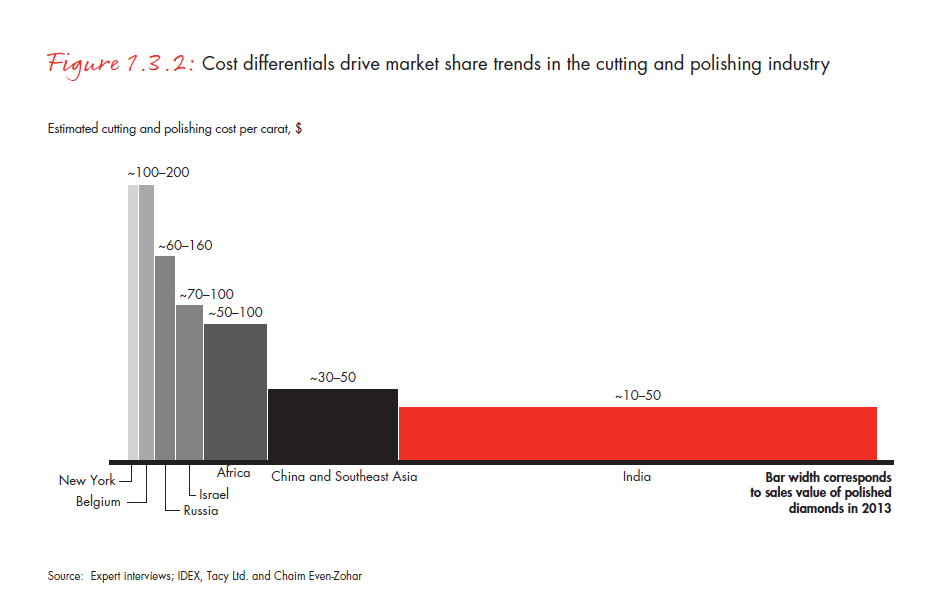
Key challenges
The cutting and polishing segment of the diamond industry must contend with three major, interconnected challenges:
- The need to continuously improve operating effectiveness to mitigate the pressure on margins caused by growing input costs and long-term rough- and polished-diamond price trends
- Obtaining needed financing of cutting and polishing activities
- Increasing requests for certification from jewelry manufacturers
As we discuss in greater detail in Chapter 3, financing issues are reshaping the middle market’s way of doing business, and market risk is increasing as middle-market margins tighten. More restrictive regulatory regimes such as Basel III have compelled traditional finance players—particularly diamond banks—to reduce their debt loads.
Concerns that synthetic stones are entering the manufacturing pipeline undetected have prompted an uptick in demand for certification. The demand puts additional pressure on the cutting and polishing segment and extends processing times.
The financing and certification trends have lent new urgency to the search for greater operating efficiency. Labor cost optimization and technological innovations such as new cutting machines are key elements of this search.
1.4 Diamond jewelry manufacturing and retailing
As a general rule, the performance of the downstream segments of the diamond industry—manufacturing and retailing—correlate closely with the performance of the global market for luxury and hard luxury goods such as jewelry and watches. In 2013 the global luxury market grew 5% to $288 billion, on the strength of unexpected shifts in regional trends (see Figure 1.4.1).
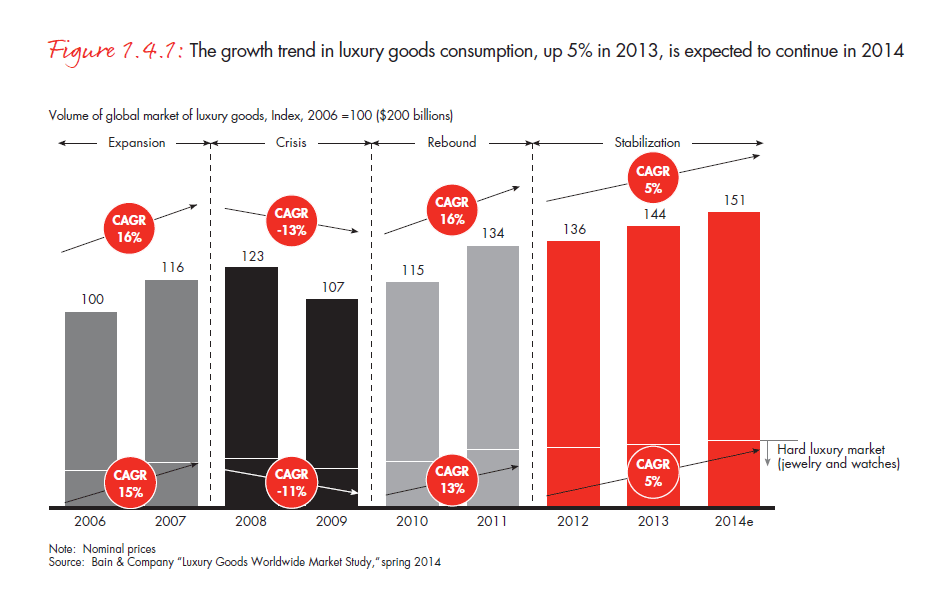
Europe, for example, improved in the second half of 2013, with the largest contributions coming from France and the UK. The US continued to grow, albeit at a slower pace than in 2012. Together, Europe and the US account for 65–70% of worldwide demand for luxury goods.
Japan booked double-digit growth in real terms, but the yen’s devaluation in the wake of Japan’s expansionary monetary policy offset that growth. Growth in China slowed markedly, especially in mainland China, as the government’s new anticorruption measures, still being implemented in various regions, began to take hold. Other emerging markets, such as the Gulf region and Africa, reported healthy growth.
The product category that led the growth of the luxury sector was accessories, which benefited from global price increases. Shaking off the impact of reduced demand in China, the hard luxury subsector grew 5%, in line with the overall market in luxury goods. The trend toward democratization of hard luxury items was clearly visible in the outperformance of affordably priced jewelry and watches. Both diamond jewelry retail sales and the value of diamond content roughly mirrored the growth of the hard luxury market itself, posting 3% gains and topping their precrisis levels (see Figure 1.4.2). Euromonitor confirmed the growth trend.
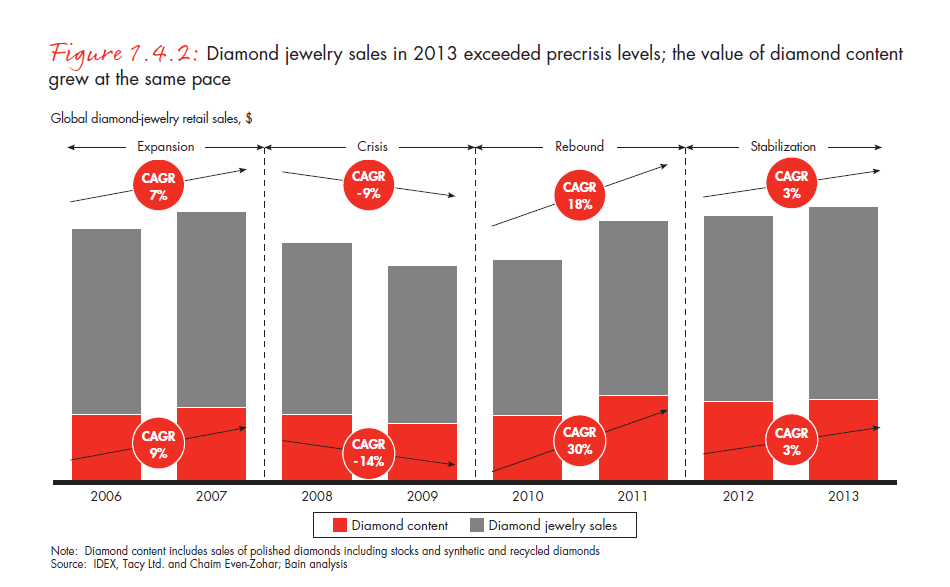
Notable trends
There are three notable trends in the diamond jewelry retail: diamond recycling, the growing role of e-retailers, and forays into further upstream integration by the major retailers.
Diamond recycling
Recycling has now arrived at the retailer’s shop floor. A number of high-end retailers now offer to repurchase stones from customers. De Beers, through a stand-alone venture, the International Institute of Diamond Valuation (IIDV), is running a small-scale program with a limited number of retailers in the US to assess the effectiveness of existing approaches to re-selling and to explore how they can be developed and improved for the consumer. These activities will probably reinforce certain brands, such as De Beers’ Forevermark. They might also contribute to increased market transparency and liquidity—crucial elements in the development of diamonds as an investment. Following a surge in volume during and immediately after the financial crisis, diamond recycling now accounts for about $1 billion in polished diamonds. Recycling is gaining popularity in the US, as is vintage or recast jewelry.
Continued advance of e-tailers
Online stores such as Blue Nile and marketplaces such as Amazon.com, Alibaba.com, and eBay claimed a growing share of diamond and diamond jewelry distribution, at a rate consistent with the overall growth of e-tailing. In the US alone, e-tailers account for 13% of total jewelry sales and 18% of volume.
Growth of online sales presents the industry with both an opportunity and a challenge. On the one hand, online offers an additional sales channel; on the other, it poses a threat to brick-and-mortar retailers because online channels offer greater price transparency and wider inventory, enable shoppers to quickly and easily compare individual stones, and have lower operating costs. The online channel likely represents the biggest threat to smaller chains with unclear differentiation of their diamond jewelry.
Forays by jewelry retailers upstream
Over the past few years, diamond jewelry retailers have been expanding their operations further upstream by setting up cutting and polishing operations. Tiffany & Co. And Chow Tai Fook, for example, have established operations in cutting and polishing, with Chow Tai Fook most recently opening its fourth diamond-cutting and -polishing site in Botswana. Signet Jewelers, one of the largest specialty jewelry retailers in the US and UK and traditionally a big buyer of polished stones, acquired a cutting and polishing factory in Gabarone, Botswana. Even though the polishing and cutting businesses’ production accounts for a small portion of the overall polished- diamond demand for some of these players, such moves nevertheless represent an important step for the industry.
In 2014, the diamond jewelry retail sector saw two major acquisitions. In May, Signet Jewelers announced that it had completed its acquisition of Zales, leading to significant consolidation of the US market. Another big deal was the acquisition by Chow Tai Fook, the Chinese jewelry giant, of Hearts on Fire, a US maker of branded luxury diamonds. The acquisition, announced in June, confirmed the increasing strength of Asian downstream players.
Recent developments in jewelry manufacturing
Turning to jewelry manufacturing, we noted earlier that manufacturing revenues grew 3% from 2012 through 2013. At the same, the manufacturing business has become significantly more concentrated. China cemented its leadership position in jewelry manufacturing, as global players such as Chow Tai Fook and Chow Sang Sang continued to consolidate multiple steps of the value chain in China, integrating cutting and polishing operations with manufacturing and retailing to better control the efficiency and reliability of production processes.
India’s manufacturers posted growth in the low single digits as they continued to cede volume to China. All other manufacturing countries and regions, including Europe, North America, and Southeast Asia, saw their shares contract further as they confirmed their niche as specialists in high-end stones.
The major trend shaping the manufacturing subsector is market consolidation. In China especially, major players are capturing scale economies by consolidating the value chain and integrating polishing, manufacturing, and retailing. Scarce liquidity has also worked to the advantage of deep-pocketed major players, which, unlike many smaller players, have the financial wherewithal to withstand prolonged credit squeezes.
1.5 Key takeaways
- Every segment of the diamond industry value chain bucked the negative trends of 2012 and posted moderate growth of 2–4% in 2013.
- In line with an increase in Kimberley Process–certified production volumes and rising rough-diamond prices, rough-diamond sales grew by 2% in 2013. Cutbacks at smaller producers smoothed the increase.
- Prices of both rough and polished diamonds have corrected since the peak of 2011 and are beginning to trend moderately upward. There is variation within polished-diamond price growth, with prices for small stones growing faster than prices for large stones. Stones of less than 0.5 carats are showing particular strength, growing in the mid-single digits.
- All live major producers increased both production and profitability, despite rising operating costs and production challenges.
- Cutting and polishing revenues topped $22 billion in 2013, a 4% increase. India, the segment leader, accounted almost solely for the market’s growth. The segment faces three major continuing challenges: achieving greater operational efficiency, meeting increasing demands for certification, and securing financing.
- Retail sales of diamond jewelry grew by 3% in 2013, supported by continued strong demand from China and a recovering US market.
- The most recent GDP growth forecasts suggest healthy diamond-jewelry demand growth in the medium term in both developing and developed countries. Some uncertainty remains, however, about the European economic outlook.
- Jewelry manufacturing revenues grew by 3%. China now accounts for the largest share of global jewelry production.
- Industry insiders report that the positive trends held up during the first half of 2014, positioning the industry to maintain momentum along every step of the value chain and raising expectations for the crucial holiday selling season.
2. Key challenges facing the industry
Now that the diamond industry has successfully recovered from the economic downturn and returned to a stable growth trajectory, we have identified four questions that currently are top of mind for various industry participants and are important in defining the long-term outlook for the industry’s development.
- How can the industry sustain long-term demand for diamonds, both in diamond jewelry and for investment purposes?
- How can jewelry retailers and manufacturers secure long-term access to gem-quality stones of an assortment that fits their specific requirements (a must if they are to sustain their growth)?
- Do synthetic diamonds pose a threat to demand for natural diamonds in jewelry? What is their role in the market?
- What impact will the evolution of diamond financing have on the industry?
There is a growing consensus among players in the diamond business that the declining availability of financing is one of the industry’s most pressing issues and that it particularly affects the ability of middle-market players to maintain and grow their businesses. We will address the ramifications of that issue in the next chapter. This chapter focuses on the three remaining challenges, each of which carries significant consequences for producers, middle-market players, manufacturers, and jewelry retailers.
2.1 Sustaining long-term demand for diamonds
The diamond industry has enjoyed a remarkable run of success since the mid-twentieth century, compiling a record of strong growth and recovering with impressive speed and resiliency from macroeconomic and political turbulence. To sustain that run, players along every segment of the value chain have one crucial task to execute, and execute well: keeping alive the emotional appeal of diamonds.
Other opportunities exist to stimulate demand for diamonds over the long term, chief among them the development of a market for diamonds as an investment. But complexities and challenges hinder that market’s development, and overcoming them will require the industry’s collective effort.
As long as the potential of the diamond investment market goes unfulfilled, consumers will remain the main engine of demand. Consumer demand accounts for 95% of today’s diamond market; demand for investment diamonds accounts for less than 5% of the total value of polished diamonds. Multiple stakeholders are tracking the latter number carefully for signs that an investment market for diamonds is gathering momentum.
Consumer demand for polished diamonds in jewelry
The industry’s support for consumer demand has gone through three major phases since the second half of the twentieth century. In the first phase, De Beers invested heavily in generic marketing to promote diamond jewelry in the major international markets (listed by size) of the US, Western Europe, and Japan. In the second phase, De Beers shifted its focus to building affinity for diamonds—and thus demand—in developing markets such as China and India. In the third—and current—phase, branded marketing has replaced generic marketing, and downstream players, including diamond jewelry retailers and middle-market players, are taking more responsibility for its execution (see Figure 2.1.1).
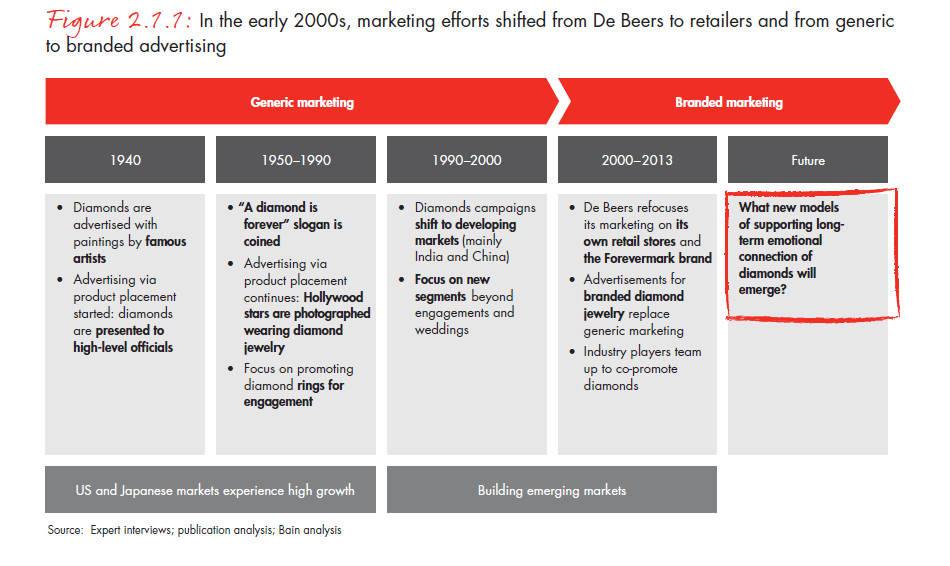
Branded (as opposed to generic) advertising emerged in the early years of the new century. De Beers took part in this shift, moving away from generic campaigns and toward supporting its retail business, its proprietary Forevermark brand, and proprietary collections of diamond jewelry. The Forevermark brand has gained new slogans such as “A true promise will never be broken,” and new jewelry collections such as the Aria Collection and campaigns such as “Moments in Light” and “Natural Brilliance” reinforce each other. Other players have made similar moves, such as Rio Tinto’s marketing campaigns for its pink stones and Hearts on Fire’s heavy advertising of its proprietary diamonds (Chinese jewelry giant Chow Tai Fook acquired Hearts on Fire in 2014). In parallel, major branded diamond jewelry retailers have invested in promoting their own branded diamond products to maintain demand and sustain their growth plans.
Different players in the industry have also teamed up to promote diamonds and diamond jewelry. Rio Tinto, for example, launched an initiative called “The Fashion of Diamonds” in 2014, engaging Chinese designers and jewelry manufacturers to incorporate diamonds from Rio Tinto’s Argyle mines in jewelry that caters to Chinese consumer tastes. The year 2014 also marks the fourth anniversary of Rio Tinto’s marketing partnership with Chow Tai Fook. The partnership promotes jointly created jewelry collections that feature Argyle stones. ALROSA, for its part, has been working with Christie’s and Sotheby’s to market its unique polished diamonds through auctions designed to generate excitement—and headlines (see Figure 2.1.2).
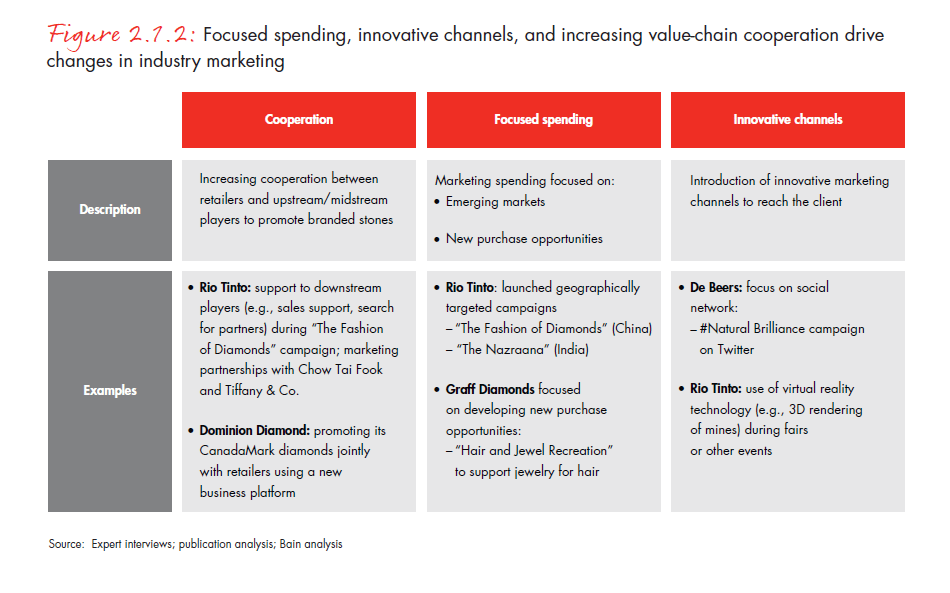
Amid all these efforts, one question looms large: What new modes of evoking the emotional power of diamonds will emerge to generate long-term demand and sustain the industry’s success?
Demand for diamonds as investment products
Demand for diamonds as investments is still quite limited, accounting, we estimate, for less than 5% of the total value of polished diamonds. To gauge the significance of that number—and hence the market’s growth potential—it is helpful to compare investment demand for diamonds with investment demand for precious metals such as gold and platinum (see Figure 2.1.3).
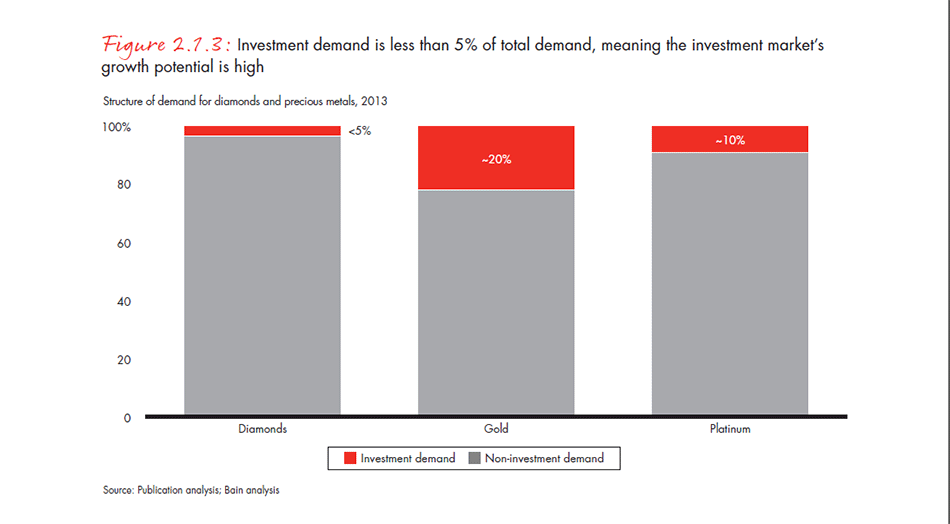
There are two main motivations for investing in precious metals: maximizing returns and hedging. Return-oriented investors invest in the metals in hope of generating above-market returns through price appreciation. Hedge-oriented investors seek a stable store of value to preserve their capital or to dampen the volatility of their overall portfolios. At different stages of the economic cycle, one or the other category of investor typically dominates the market for a given commodity.
Experts in the private banking industry attest that after the 2008 financial crisis, hedge-oriented investors accounted for most of the demand for commodities—especially precious metals. Although the large majority of such investing is still focused on paper assets such as exchange traded funds (ETFs) concentrated in gold, demand for hard assets grew at a stronger rate than overall demand.
Investors looking for a hedge against inflation might be persuaded to consider diamonds, which historically have combined low volatility with price growth in excess of the inflation rate. Overall, polished-diamond prices have risen at a compound annual rate of 5% since 2009, higher than the inflation rate, and certain categories of diamonds have grown at even higher rates. At the same time, diamond prices have been more stable than those of silver, gold, and platinum, fluctuating 12% since 2009, 2.8 times less than silver prices, 1.6 times less than gold prices, and 1.1 times less than platinum prices (see Figures 2.1.4 and 2.1.5).
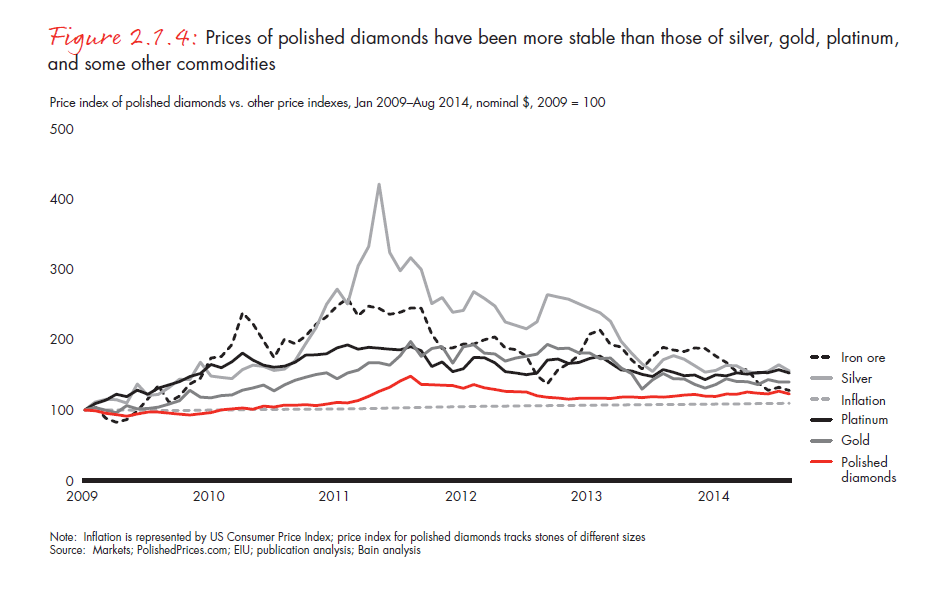
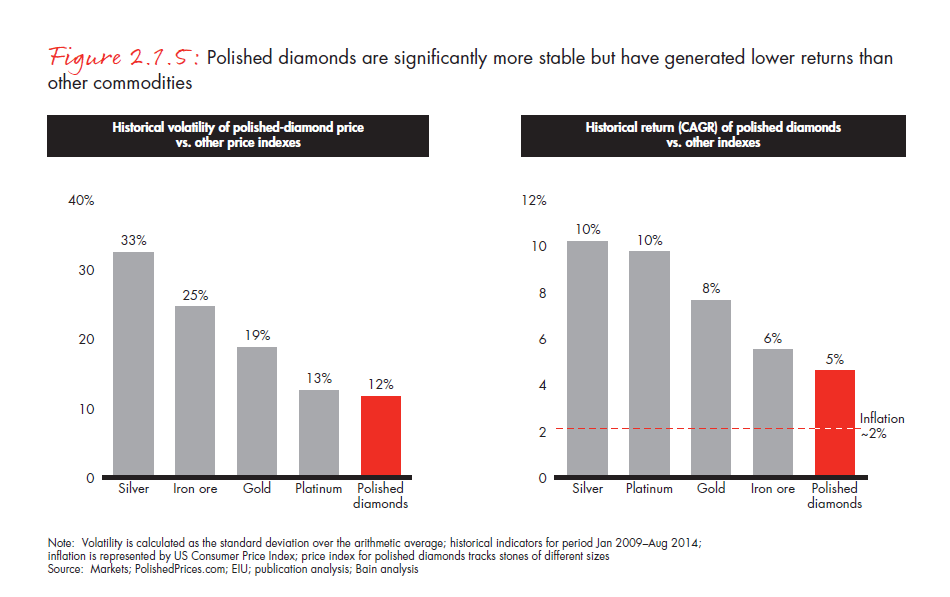
In addition, diamonds possess an emotional characteristic that differentiates them from precious metals: their aspirational status as a luxury good.
Investors considering taking a position in diamonds have several options. Individuals can purchase physical stones—either individual stones or sealed boxes of stones known as diamond bullions—from diamond traders or specialized retailers. Diamond bullions are usually filled with small stones of a defined type and can range in price from approximately $100 to thousands of dollars. One company currently offering diamond bullions is Provident Metals.
Some private banking clients can also invest directly in physical diamonds. A few private banks offer their high-net-worth individual customers access to diamond purchasing, valuation, and certification services. For example, Singapore Diamond Investment Exchange (SDIX) partners with private banks to offer such dedicated services, as does the Los Angeles–based Investment Diamond Exchange (IDX).
Investors can also gain exposure to prices of polished diamonds through asset management firms, a handful of which buy and hold stores of physical diamonds. They sell shares that entitle holders to a pro rata portion of the value of the diamond stores. The funds typically purchase polished colorless stones weighing 1 to 5 carats, which are considered to be investment-grade diamonds. Among the asset managers offering such funds are Diamond Capital Fund and Swiss Asset Advisors.
As an alternative to buying physical stones, investors can purchase shares of companies in the diamond industry. The value of such shares, however, does not correlate perfectly with the value of diamonds themselves, because the dynamics and risks of diamond industry companies—wherever they stand in the value chain—do not perfectly match those of physical diamonds.
That said, investors can gain exposure to diamonds by purchasing either the shares of companies that participate directly in the diamond value chain—that is, miners, cutters and polishers, jewelry manufacturers, and retailers—or the shares of strategic suppliers to those companies. The market, especially private equity funds, has displayed a particularly strong appetite for shares of strategic suppliers focused on key technologies for the diamond value chain, including exploration and production equipment, cutting machines, synthetic-diamond production technology, and synthetic-diamond detection technology.
To facilitate such investments, some fund managers have repeatedly attempted to create funds backed by shares of diamond industry companies. These funds typically acquire shares of companies involved in various segments of the value chain, with the aim of replicating industry-specific risks and growth opportunities such as exposure to polished-diamond prices.
Despite the appeal of diamonds as a possible alternative component of a diversified investment portfolio, persistent structural issues have constrained the growth of an investment market for diamonds. These issues include the following:
- The difficulty of appraising diamonds and the lack of uniform pricing. Unlike gold, diamonds are not fungible—one carat is not necessarily equal to another carat. Diamond pricing is inherently subjective, based on emotional factors as well as considerations of clarity, color, cut, and carat size (the diamond industry’s “4 Cs”). There are more than 20,000 possible permutations of those characteristics, which defeats attempts to establish a standard per-carat price.
- Lack of pricing transparency. Although e-tailers and other new players have brought a higher level of transparency to the market, the industry is still far from creating an industry-standard, reliable price index embraced and trusted by diamond and investment professionals alike. Such an index would enable investors to mark physical-diamond portfolios to market and also serve as a benchmark for communication and target-setting between investors and advisers.
- Lack of market liquidity. Most diamonds are still bought and sold in private transactions, and even diamond exchanges that centralize trading activity do not guarantee that diamond holders can sell their diamond stock at a moment’s notice. And the myriad product segments, created by thousands of permutations of diamond characteristics, also make it difficult to liquidate a diamond portfolio quickly if necessary.
These structural issues have created several secondary challenges:
- A lack of convenient financial instruments. In the absence of a price index, the industry has been unable to develop an ETF or other tradable instrument that would approximate diamond price trends without requiring physical goods. According to financial services experts, such products are key to supporting diamond demand within the private banking industry.
- Shortage of market knowledge and transparency. Because of its intrinsic complexity, the industry is still opaque and arcane to most market participants, which hinders their ability to trade diamond investments for their own accounts or sell them to customers. Much progress already has been made in enhancing market transparency in recent years.
To overcome or mitigate these challenges and to stimulate investment demand for diamonds, the industry must meet a number of requirements. The first is to enhance and automate appraisal procedures. That would facilitate the exchange of information and help industry participants narrow the gap between their valuations. The second is to create a transparent, universally recognized and accepted price index that would establish a firm spot price for diamonds.
The industry also needs to develop widely accessible and scalable diamond-trading platforms. The presence of such platforms would reassure investors that they could, if necessary, liquidate their holdings quickly, easily, and at a fair price. As mentioned before, De Beers through IIDV is currently assessing the effectiveness of existing reselling approaches and exploring directions of potential improvement, an initiative that will likely contribute to increasing market liquidity, at least for a specific brand of diamonds. Creating financial products directly linked to diamond prices is another requirement for developing the investment market. Such products would expand the market beyond investments in hard stones. And finally, it is in the industry’s interest to invest in continuing education for both finance professionals and investors, who without help may find the diamond market overly complex and intimidating.
Key takeaways
- Since the early 2000s, the diamond industry’s marketing efforts have shifted from generic marketing, largely supported by De Beers, to brand advertising supported by retailers or producers.
- De Beers is still an active marketer, but it has shifted its focus to promoting its own Forevermark diamond brand and its retail business. Major players along the value chain—including retailers, jewelry manufacturers, cutters and polishers, and producers—are teaming up in increasing numbers, on the theory that collaborative marketing encompassing multiple segments of the value chain can better address consumer preferences.
- Major players have started to create innovative marketing tools in the changing media space to keep abreast of changing consumer preferences and habits.
- Investment demand for diamonds still accounts for less than 5% of polished-diamond value; comparison with gold and platinum indicates that this market has ample untapped potential.
- Diamonds could serve as a low-volatility hedge against inflation. Diamond prices are almost 3 times less volatile than silver prices, 2 times less than iron ore prices, and 1.5 times less than gold prices.
- Investors can take a position in diamonds by purchasing physical stones. Alternatively, they can purchase investment vehicles that give them exposure to either hard assets or diamond-related companies.
- There are three persistent fundamental challenges that hinder the development of a diamond investment market: difficulty of valuation and appraisal, lack of price transparency, and lack of market liquidity. The industry continues to work on initiatives to address these challenges. Accelerating the creation of a diamond price index and setting up a liquid secondary market are key to stimulating investment demand for diamonds.
2.2 Securing long-term access to diamonds
In 2013, producers extracted 130 million carats of rough diamonds and the production of polished diamonds was about 25 million carats—roughly 20% of rough-diamond output. Some 55 million to 65 million carats of rough-diamond production were classified as industrial grade, and about 40-50 million carats of the remaining volume were lost in the polishing process (see Figure 2.2.1).
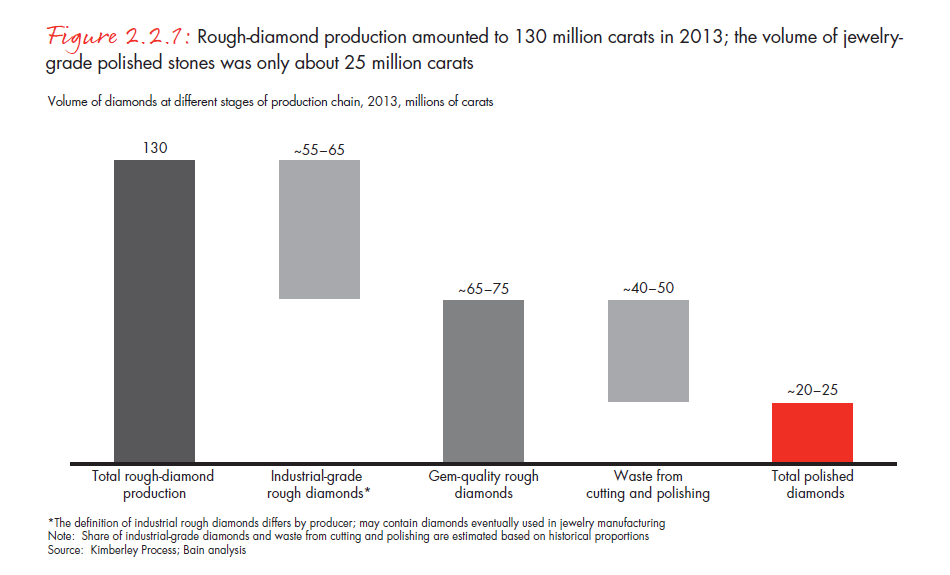
Large stones of one carat or more are relatively rare, making up only about 10% of polished-diamond volume but accounting for about 35% of polished-diamond value. Stones of three or more carats make up less than 2% of polished- diamond volume and about 5% of value. Major luxury retailers are the main purchasers of these extraordinary gems. Because such large stones, especially of high clarity and color, are increasingly rare, their prices have historically outperformed price growth in the overall market, rising 150% in the past ten years, compared with a 120% increase for stones of 1–2.99 carats and a 60% rise for the overall market (see Figure 2.2.2).
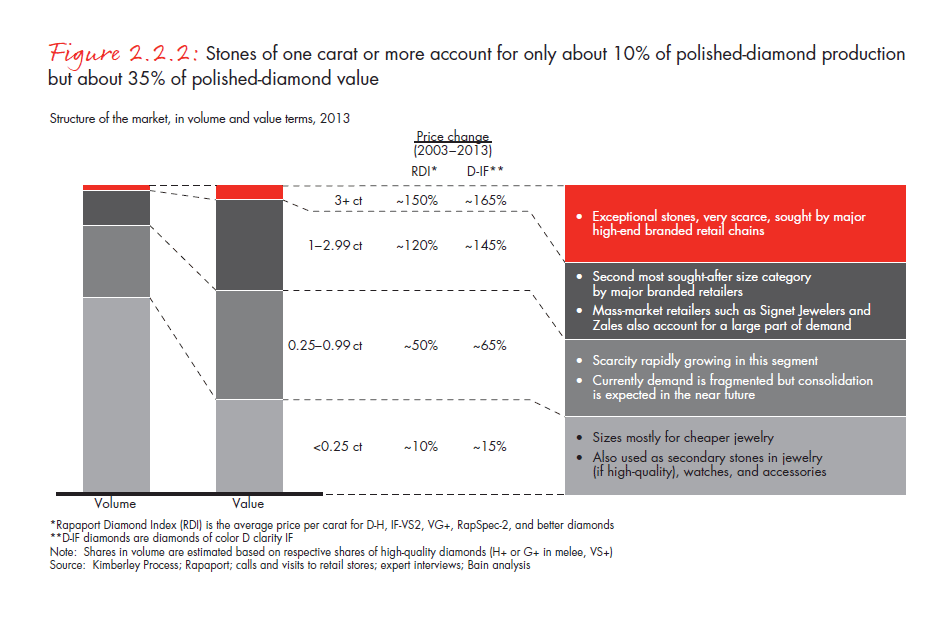
Adding further stress to the supply-demand balance for polished diamonds is the growing demand for diamond jewelry, which is expected to outstrip supply by a considerable margin in the long term. The gap is expected to widen beginning in 2019 as production flattens (see Figure 2.2.3).
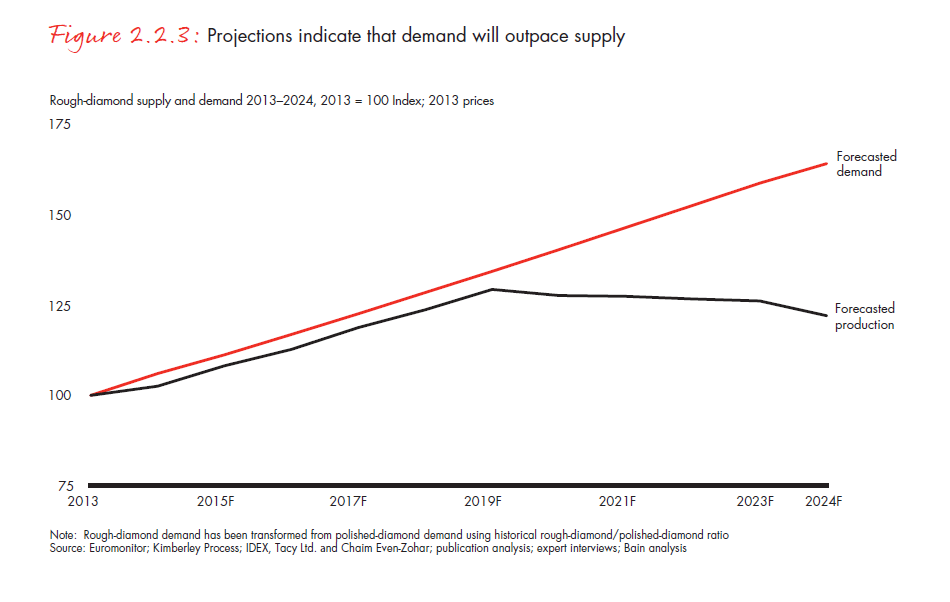
At the same time, to ensure that diamonds come from ethical, conflict-free sources and are natural, diamond jewelry retailers increasingly feel the need to trace the diamonds to their origins in a particular country or even a particular mine.
Historically, the major branded retail chains, including the luxury segment maisons and the big Asian players, have posted greater revenue gains than the overall diamond-jewelry market. From 2011 through 2013, for example, the revenues of the select top retailers climbed 14% on average. If top-performing retailers plan to continue their considerable growth into the future, they need to ensure the availability of the right assortment of polished diamonds (see Figure 2.2.4).
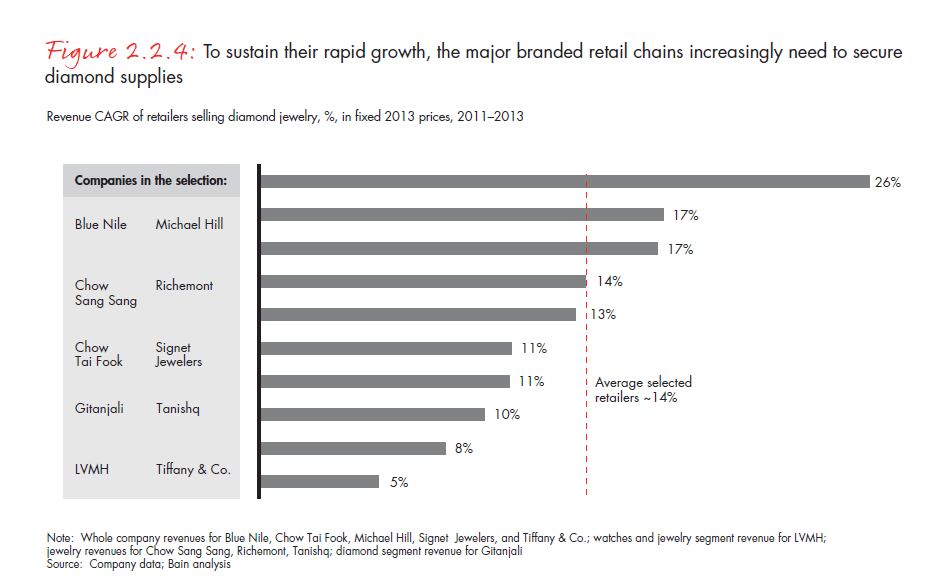
Before we analyze the options available to diamond jewelry retailers to resolve their long-term supply dilemma, consider again the structure of the value chain that supplies gem-quality stones to retailers. In contrast to the concentration of the upstream segment, which is dominated by a handful of mining companies, the middle and downstream segments of the diamond value chain are highly fragmented, with more than 200,000 retail players, 10,000 jewelry manufacturing companies, and 5,000 cutting and polishing companies. The top miners account for about 85% of all rough production by value, and up to 110 long-term contract holders and sight holders, most of which are vertically integrated to a greater or lesser degree, control more than 70% of that supply by value (see Figure 2.2.5).
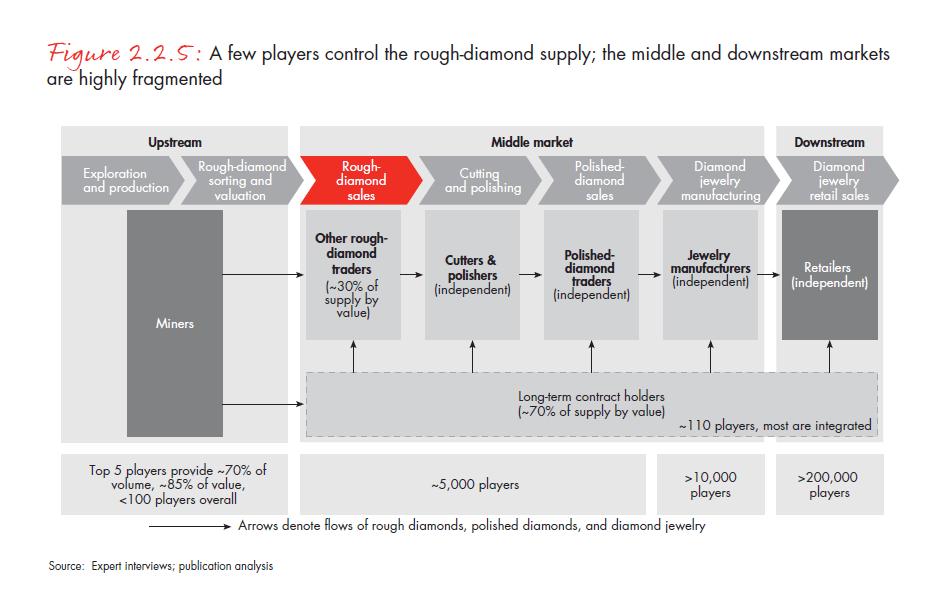
This environment presents downstream players with two major challenges: securing a long-term supply of stones and verifying those stones’ traceability. The verification process includes two primary elements. The first is to confirm that the diamonds were traded through official channels and that they comply with the Kimberley Process, which bars trading in diamonds mined in conflict zones and other embargoed areas. The second is to authenticate the diamonds as natural—an increasingly necessary measure that reflects growing industry concern over the threat of synthetic diamonds entering the production pipeline undetected.
As a result, an increasing number of players along the value chain are demanding that stones be authenticated and traceable, and to that end, the players are taking action to work more closely with producers. Both luxury and mass-market retailers, despite the differences in the assortments of gems they seek to secure, want to lock in access to either miners or key traders (that is, long-term contract and sight holders).
In pursuit of this objective, diamond jewelry retailers in recent years have been moving further upstream. Tiffany & Co. was one of the earliest upstream movers, consistent with its overall strategy of vertical integration that encompasses every segment of the value chain. In 2002 it established Laurelton Diamonds, a wholly owned subsidiary that sources, cuts, and polishes rough diamonds. From 2003 to 2013, Laurelton opened facilities for quality assurance, sorting, cutting, and polishing in Antwerp, Botswana, Cambodia, Canada, China, Mauritius, Namibia, South Africa, and Vietnam.
In addition, from 1999 through 2013, Tiffany & Co. signed purchase agreements with producers including Aber Diamond Corporation, BSG Resources, DiamondCorp, Gem Diamonds, and Tahera Diamond for supply from specific mines. In some instances, Tiffany & Co. complemented these agreements with equity investments.
In 2004, for example, the company secured the entire production of Tahera Diamond’s Jericho mine in exchange for financing the site’s operation. In 2009, it signed a purchase agreement to buy yellow diamonds from Gem Diamonds. In 2012, Laurelton Diamonds obtained a long-term supply contract from ALROSA and now is a sight holder of all three top rough-diamond producers: ALROSA, De Beers, and Rio Tinto.
Graff Diamonds is another co-owner of Gem Diamonds, with a 15% equity stake. Graff’s relationship with Gem Diamonds includes an agreement to purchase the largest stones from the Lesotho mine and joint use of a cutting facility in Johannesburg.
Chow Tai Fook is another leading retailer that is pursuing a vertical integration strategy by extending itself upstream, in its case by entering into long-term supply contracts with the three largest diamond producers by volume, ALROSA, De Beers, and Rio Tinto. Chow Tai Fook has also positioned itself in the midstream, starting in 1988 with the opening of Foshan Yu Shun Fu Jewellery & Diamond Co., whose holdings include a diamond-processing and -manufacturing facility in Shunde. In 2011, the retailer acquired Zlotowski’s Diamond Cutting Works, a Diamond Trading Company sight holder with which it had been linked for nearly 30 years through a contractual relationship. More recently, Chow Tai Fook opened a diamond-cutting and -polishing facility in Botswana.
Another retailer that recently integrated upstream was Signet Jewelers, which bought a polishing factory in Botswana.
In addition to these examples, the push by large integrated retailers to secure long-term diamond supplies is evident in the evolution of the producers’ contract-holder portfolios. Since 2010, the percentage of integrated retailers in long-term contracts or in sight holder status with producers has roughly doubled, to about 20% (see Figure 2.2.6).
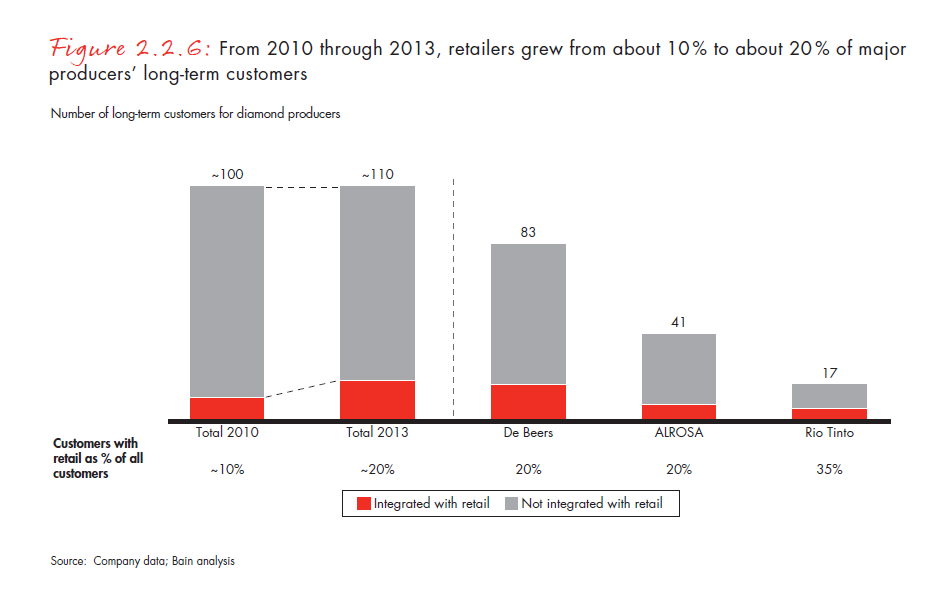
Based on the historical experience of diamond jewelry manufacturers and analysis of the current situation, we see several strategic options available to retailers for securing diamond supplies. These can be summarized in a simple, two-dimensional scheme. Those dimensions are the retailer’s target level of integration—does it extend all the way upstream or stop at the middle market?—and the type of agreement the retailer enters into with the producer. The agreement could take the form of a long-term supply contract or, alternatively, a loan or equity investment.
Typically, retailers can structure their agreements in one of four ways: a supply agreement or sight or contract holding with a producer, a supply agreement with a middle-market player, an investment in a producer, or an investment in a middle-market player (see Figure 2.2.7).
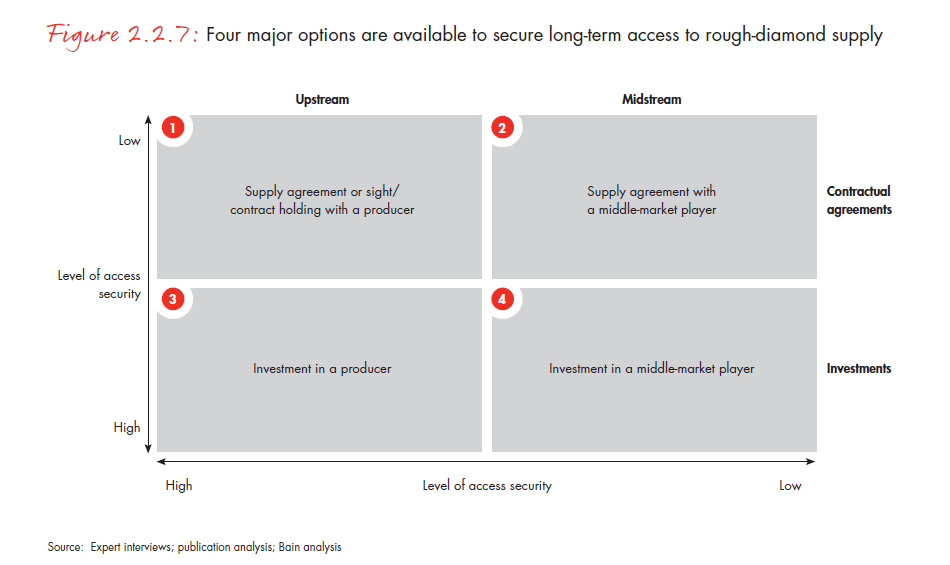
In choosing among the options to secure long-term access to the diamond supply, retailers need to weigh carefully the costs of each option, given their required assortment of smaller or larger stones, the risks of doing business in a particular geography of operations, the new capabilities (if any) that they will need, and the risks inherent in entering new businesses.
A supply agreement with a producer
The most secure type of agreement is a supply agreement or sight or contract holding with a producer. Such an agreement would allow the retailer to secure a significant portion of the specific assortment of rough diamonds that it needs and the greatest degree of traceability. This option, however, requires retailers to have the stones cut and polished and to offload stones that do not match their specific needs.
Long-term contracts afford retailers only a limited ability to match the assortment of diamonds they purchase with the preferences of their customers for stones of a particular size and quality. Because under long-term supply agreements companies receive an assortment that is wider than their specific requirements, retailers need to develop trading operations to offload unwanted inventory.
As well, the retailers need to figure out how to cut their stones in the most effective way. They can choose either to set up their own cutting and polishing operations, as many have done in the past, or to subcontract cutting and polishing to middle-market players or rough-diamond producers that have such capabilities.
A supply agreement with one or more middle-market players
Supply agreements with middle-market players enable the retailer to select only the types and quality of diamonds they need to manufacture jewelry. As a result, retailers do not need to enter the cutting and polishing business or develop trading capabilities to offload unwanted supplies. In assessing this option, retailers need to consider that the risks of doing business in developed countries are lower but that the economics for manufacturing smaller stones are better in the developing countries.
The key challenges of such agreements are that they do not provide direct access to rough-diamond supplies and thus will not fully ensure the traceability of the stones. They can also require multiple agreements to fulfill the required volumes.
An investment in a producer
Investments in producers can be structured as either equity investments or loan commitments. They typically accompany a long-term supply agreement on terms favorable to the investing retailer. These investment agreements often serve to advance and deepen an existing relationship with the producer, strengthening both sides’ commitment to the partnership by imposing more rigorous contractual obligations on them. By formally establishing the retailer’s financial influence over the producer, the agreement secures the highest degree of access to the producer’s output. That is an especially important consideration for very large retailers buying significant volumes.
Some retailers also favor these agreements because they allow the retailers to trace any given stone all the way back to the mine. But only a handful of small producers are available to accept investments at any given time. These agreements also require retailers to invest in facilities to cut and polish the output, either by integrating into the middle market or by partnering with a cutting and polishing specialist.
Perhaps most important, investments in producers expose retailers to the risks inherent in diamond production operations—risks that (as we described in Chapter 1) are quite unlike the risks of retailing, or indeed any other part of the diamond value chain.
An investment in a middle-market player
Investments in middle-market players can take several different forms, including loans, joint ventures, and equity investments at either the minority or the controlling-stake level, and can involve players at any point in the middle market, including rough traders, cutters and polishers, or polished-diamond traders. Like investments in producers, partial investments in middle-market players typically accompany long-term supply agreements with these companies.
In one respect, the fragmentation of the middle market works to retailers’ advantage. They can choose as their investment target a specialist—again, either a trader or a cutter and polisher—whose assortment matches up well with the style and quality of the diamond jewelry they offer their customers. If, on the other hand, the target does not specialize in a particular type or quality of stone, the retailer will need trading facilities to offload unwanted diamond inventories. In addition, compared with upstream investments, middle-market investments afford retailers less-secure access to production volumes.
The middle market’s fragmentation also has another potential downside for retailers. If their planned purchase volumes are high, they may need to invest in multiple middle-market players to satisfy their demand for gems.
Key takeaways
- The growing gap between demand for diamond jewelry and the supply of rough diamonds and the increase in demands from customers to ensure the authenticity and ethical origin of stones have led diamond jewelry retailers to reconsider their long-term sourcing strategies.
- Diamond jewelry retailers have addressed the issue of securing long-term access by moving up the value chain: from setting up cutting and polishing operations all the way to investments in the mine producers.
- Four strategic options are available to diamond retailers to secure long-term supplies of diamonds and the ability to trace their origin: a supply agreement with a diamond producer, a supply agreement with a middle-market player, an investment in a diamond mine or producer, or an investment in a middle-market player. Each option has its benefits and drawbacks.
- In selecting the right option for them, diamond jewelry retailers need to carefully consider economics, required capabilities, and the risks inherent in each option.
2.3 Synthetic diamonds
The technology to produce synthetic diamonds has evolved significantly in the past decade and now presents the diamond industry with both an opportunity and a challenge. Technological advances have made it to possible to create customized diamonds with particular properties suitable for advanced applications in quantum computing, biotechnology, laser optics, infrared radiation transmission, high-sensitivity sensors, and many more fields.
There are two broad categories of production technology. The older technology, high-pressure high-temperature (HPHT), emerged in the 1950s to produce industrial diamonds, used mainly as abrasives in the construction and manufacturing industries. The brown or greenish hue of HPHT diamonds and their general lack of clarity and size make them unsuitable for use in jewelry.
A newer technology, known as a chemical vapor deposition (CVD), is capable of producing synthetic diamonds of jewelry-quality size, color, and clarity. CVD technology also makes it possible to customize the characteristics of individual diamonds by using additives. Such “bespoke” diamonds are well suited to use in high-technology industries.
Producers use the two synthetic-diamond technologies to generate the vast majority of industrial diamonds. In 2013, producers turned out some 7 billion carats of industrial stones; natural diamonds accounted for less than 0.7 million carats of the industrial diamonds produced in 2013—less than 1% of total output (see Figure 2.3.1).
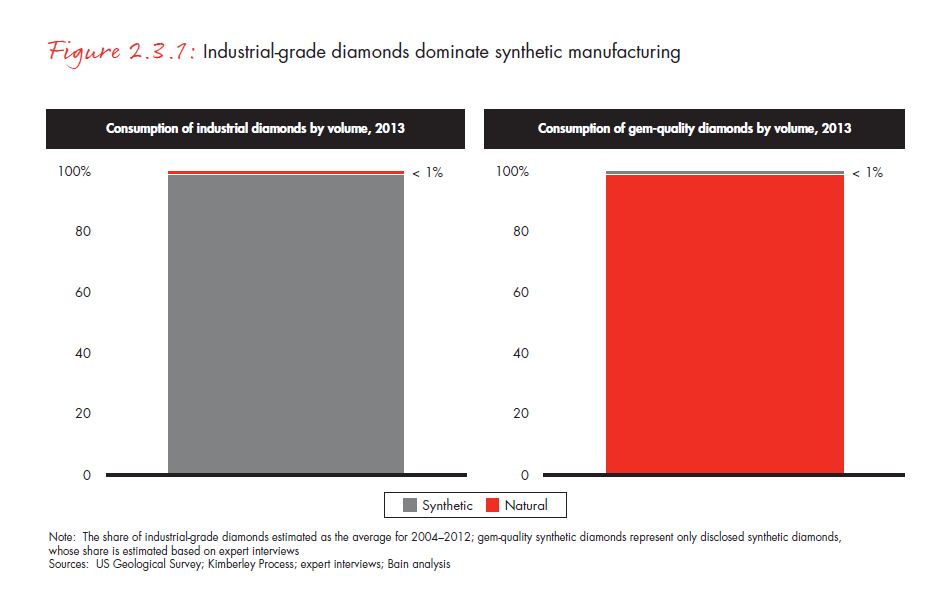
The construction industry uses some 60–65% of industrial diamonds, manufacturers and energy companies use 15–20%, and high-tech applications account for 15–25. As applications for industrial diamonds expand, the market could double in size within seven to ten years (see Figure 2.3.2).
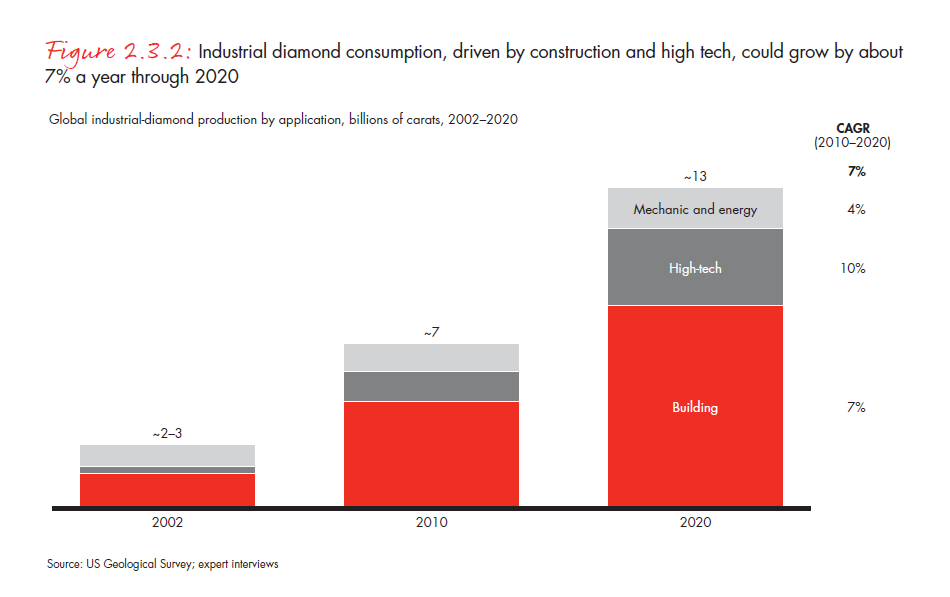
According to interviews with experts at companies participating in the industrial diamond market, prices for most synthetic-diamond powders range from $0.25 to $0.50 per carat. Prices for high-quality CVD diamonds are much higher—up to several thousand dollars for a single flawless stone. Further technological refinements could result in more affordable synthetics, a development that would spur additional demand for them for industrial applications. In fact, the industrial diamond market’s prospects offer attractive opportunities for the producers of synthetic diamonds, given the industrial market’s potential scale, growth possibilities, and stable profit margins.
Advances in CVD technology, however, present the diamond industry with a challenge as well as a significant opportunity, because it is now possible to create large synthetic stones of jewelry-quality color and clarity. The composition of the market for gem-quality diamonds is the reverse of that seen in the industrial market, with natural diamonds dominating commerce in gem-quality stones.
In part that’s because several consumer studies, including one performed by Bain & Company in 2012, found that consumers are reluctant to consider synthetic diamonds for important life occasions such as engagements and weddings. The study also showed that in general, customers perceive synthetic stones as cheap, fake, and artificial and so prefer natural gems (see Figure 2.3.3).
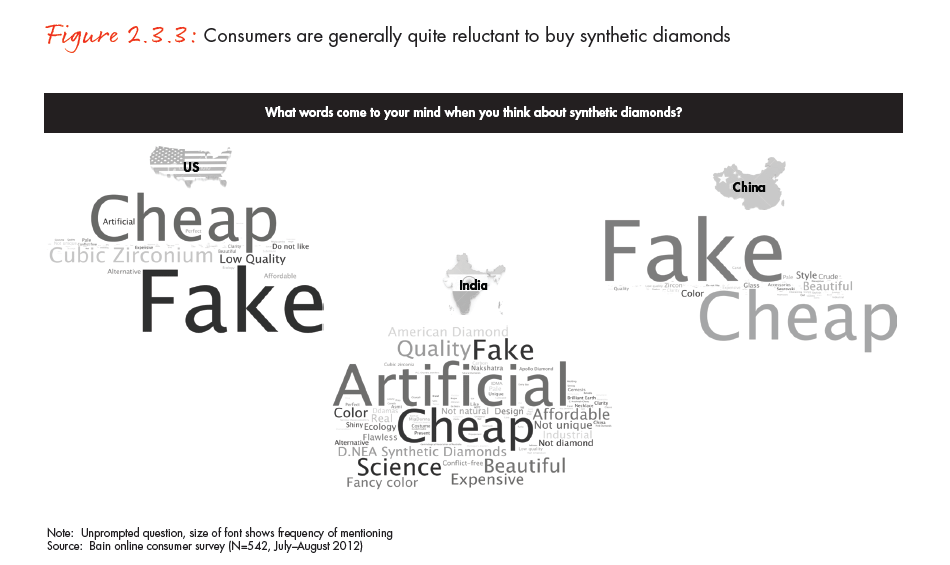
Studies and surveys conducted in 2013 have confirmed that consumer perceptions changed little from 2012. For example, a significant percentage of jewelers interviewed for one study report that their customers liken buying synthetic diamonds to buying a fake painting. The studies also revealed that customers would not feel comfortable proposing with a ring whose box clearly identifies the synthetic origin of the stone inside.
To further support the thesis that substitution of synthetics gems for natural ones is unlikely, consider the behavior of the jewelry markets for other gems, which actually expanded when lab-created gems appeared. For example, cubic zirconia, moissanite, and Swarovski crystals established themselves in the jewelry market by satisfying specific customer needs at appropriate price points.
It appears, then, that potential substitution of synthetics for natural diamonds in jewelry does not pose a threat to the industry at this time. The challenge comes from undisclosed attempts to pass off synthetic stones as natural. Such covert substitution undermines consumers’ confidence that they are acquiring a miracle of nature whose formation began billions of years ago rather than a stone created recently in the lab.
Undisclosed synthetics have entered the pipeline posing as natural diamonds on several occasions in the past five years. They have been found in certification labs all around the world (see Figure 2.3.4).
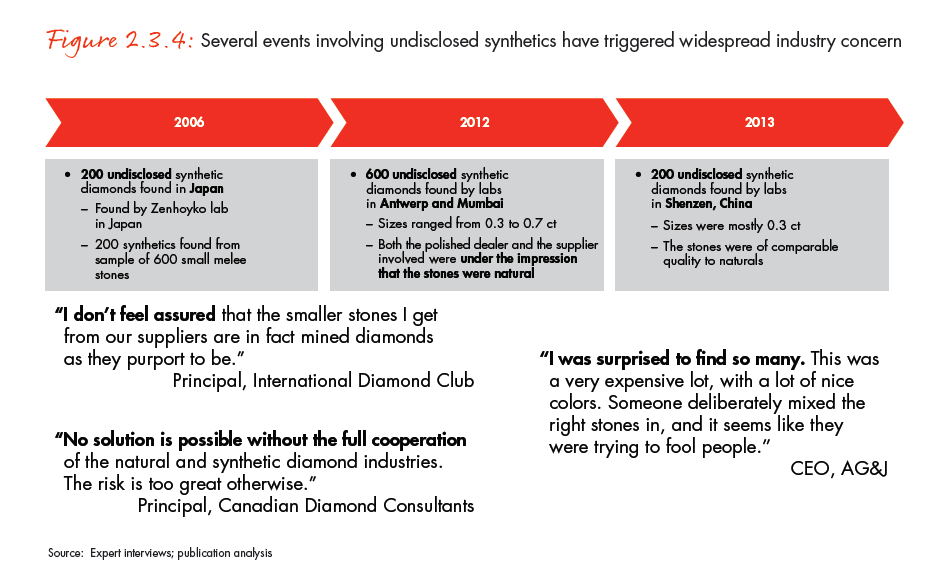
The amount of undetected synthetics circulating in the industry is a matter of debate, but industry participants—including both producers and downstream players—understand that it is in their joint interest to protect consumers from undisclosed synthetics entering the market.
A number of initiatives are under way to address the challenge of synthetic diamonds entering the diamond market undisclosed. Industry players have developed advanced detection technologies to filter out even high-quality synthetics. Middle-market players, meanwhile, increasingly request certification, even of smaller diamonds. And producers have warned sight holders and other long-term customers that if they are caught dealing in undisclosed synthetics, they will be struck from the rolls of long-term customers and denied direct access to rough diamonds in the future. The industry is also considering pushing for the development of clear, unambiguous nomenclature for synthetics and strict disclosure requirements for trades and certifications.
The two initiatives that will likely have the most visible impact on the industry are the development and installation of detection technologies and the increasing demand for gem certification. The latest advances in detection technology enable instruments and machinery to quickly scan large quantities of diamonds for synthetics. And some state-of-the-art devices can process stones by the batch rather than individual pieces—a key advance.
The machines are faster now, too—some now on the market can assess a stone in ten seconds. The machines are also able to handle a broader assortment of colors, sizes, and degrees of clarity. Detection quality continues to rise as well, and the technology is becoming cheaper, as low as $20,000 to $25,000 for a machine that can process diamond in batches, a development that will attract more retailers and dealers. De Beers is one of the leaders in developing detection technology, with four major machines to its credit: DiamondSure, DiamondView, DiamondPlus, and the Automated Melee Screening (AMS) device. Its International Institute of Diamond Grading and Research (IIDGR) is an influential force in the market. AWDC-funded research center WTOCD is also contributing to this technological improvement; it developed a handheld machine called D-Screen that can scan diamonds of different shapes (see Figure 2.3.5).
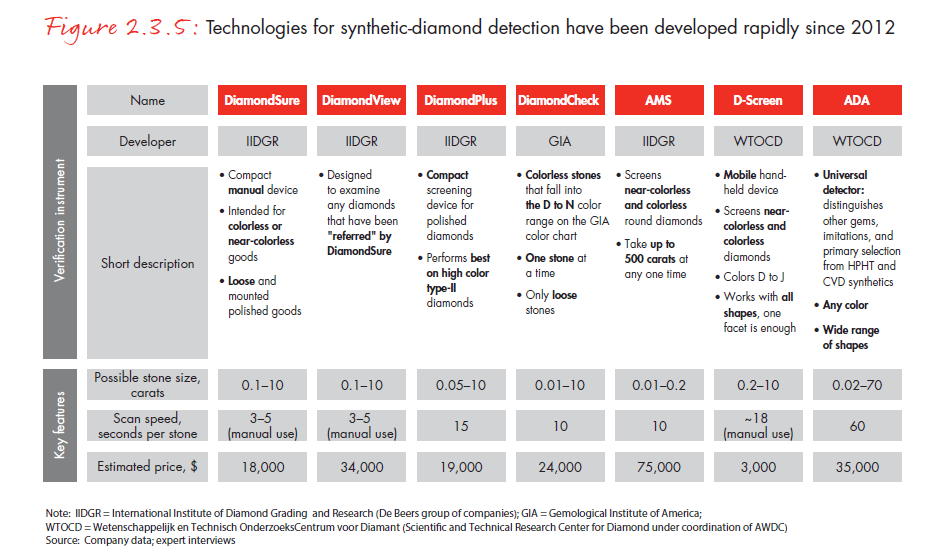
The threat of undisclosed synthetics has also stimulated demand for certain types of certification. For example, the backlogs of stones awaiting certification by the Gemological Institute of America, the International Gemological Institute, and Hoge Raad voor Diamant have swelled significantly in the past year. A disproportionately large number of requests issue from Chinese retailers, whose consumers appear to be very sensitive to the status of natural stones. Not only are retailers requesting certification of higher volumes of diamonds, but the requests have also expanded to encompass smaller-size stones. Requests for certification of diamonds of 0.5 and even 0.2 carats are coming much more frequently than in the past.
Market participants report that increasing demand for certification has led to constraints on certification capacity. As a result, wait times for certification have stretched from two to three weeks to three months or longer, creating delays in the processing of stones through the value chain. This is likely a short-term issue that will ease as the industry expands the certification business.
The two remaining reactions to the threat of synthetics aim to establish a legal and regulatory framework to govern the trade in synthetic diamonds. Some producers and retailers advocate laws that would define and differentiate natural and synthetic stones. Such laws would require traders to disclose explicitly what they offer, be it a natural stone or a manufactured one. Others would prohibit the use of the word diamond in the name and certificate of the synthetic stone.
As a long-standing matter of practice, diamond miners require their long-term customers to disclose any business they do in synthetic diamonds. A company caught dealing in undisclosed synthetics risks banishment from the community of long-term suppliers and loss of access to the primary source for rough diamonds. Complementing the threat of such sanctions are miners’ marketing efforts to emphasize the natural origin of their stones.
Reinforcing these industry-led efforts, consumers are also increasingly demanding assurances of authenticity, spurring downstream players to take additional action. As discussed in Chapter 1, some key jewelry manufacturers, especially Chinese players, are exerting closer control over the supply chain through certification, vertical integration, closer physical proximity to key suppliers, and periodic audits of suppliers’ operations.
Key takeaways
- We believe that the most attractive opportunity for synthetic diamonds is the market for high-tech and industrial applications rather than the jewelry market. Demand for industrial synthetic diamonds could double in the next ten years on the strength of increasing demand for high-tech and construction applications.
- There is no indication at this time that consumers view synthetic diamonds as acceptable substitutes for natural diamonds when they make an emotional purchase. There may be a market niche for synthetic, gem-quality diamonds similar to the niches created by cubic zirconia, moissanite, and Swarovski crystals.
- The most pressing issue involving synthetics in the past few years has been the undisclosed entry of synthetics into the diamond supply chain.
- The diamond community is addressing this issue in four ways. It is developing technology to detect synthetics of smaller and smaller sizes, promoting diamond certification more than before, working on clear legal definitions and terminology to be used by the trade and retailers when dealing in synthetic diamonds, and policing the market to ensure severe legal repercussions for companies caught dealing in undisclosed synthetics.
2.4 Diamond industry financing (short introduction)
In Chapter 1 of this report, we briefly discussed the industry’s access to bank liquidity, describing it as one of the most urgent challenges facing the industry. In Chapter 3, we will describe more fully the dynamics of diamond financing and how recent developments have affected industry players’ access to crucial capital.
As a general rule, “diamond financing” refers to finance for the middle market—traders, cutters and polishers, and, to a certain extent, jewelry manufacturers. Traditionally, this segment was served by a limited number of financial institutions, sometimes known as diamond banks (see Figure 2.4.1).
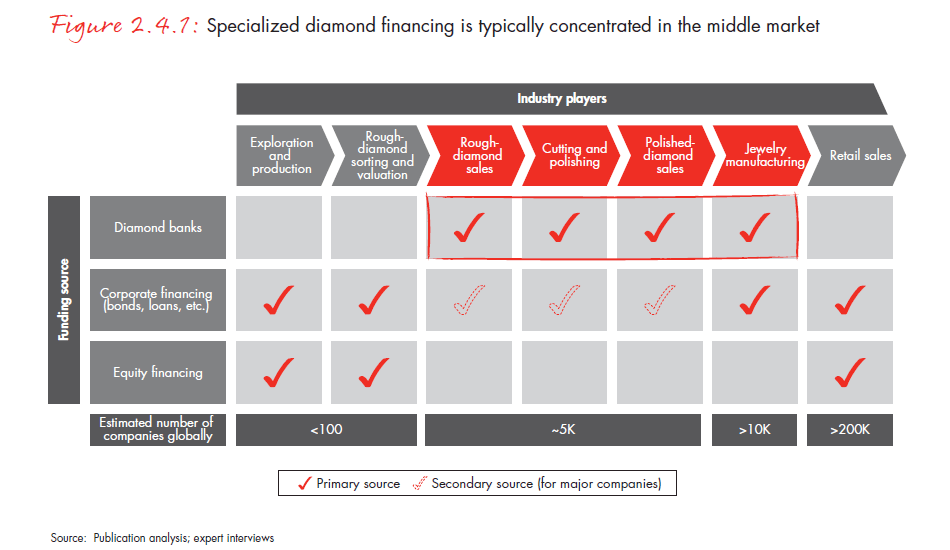
The financing provided by diamond banks has played a vital role in sustaining the industry’s growth during the past decade, as outstanding debt has more than doubled, from about $7 billion in 2002 to about $16 billion in 2013. In the past few years, however, middle-market players’ once-easy access to liquidity has been hampered by obstacles. To some extent, liquidity has tightened because of conditions in the diamond industry itself. Collectively, the middle market’s leverage has swelled in recent years (despite a focus on operational efficiency), inventory and credit-collection cycles have lengthened, and average margins have tightened.
Conditions in the banking industry have changed as well in recent years, adding to the financing stresses on the middle market. Banks have taken on increasing credit and concentration risk and face tighter regulations such as the Basel III framework and more stringent enforcement of anti-money-laundering laws. What is more, in the wake of the financial crisis, the industry has undergone a deep restructuring that has reduced credit availability in Europe and (to a lesser extent) in the US.
As a result of these converging changes, the diamond industry could be in for a short-term round of deleveraging as the financing market seeks a new equilibrium (see Figure 2.4.2).
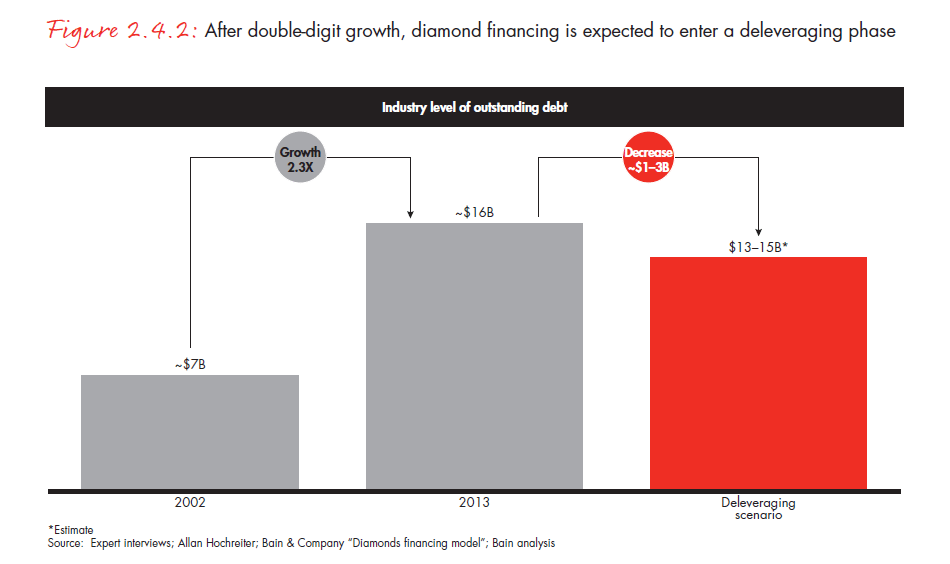
In the next chapter, we will examine the diamond industry’s financing environment and suggest actions to develop a more sustainable business model for both diamantaires and banks.
3. In-depth review of the diamond-financing industry
We will address three topics in this chapter: the definition and boundaries of the diamond-financing business, the business’s historic evolution and emerging challenges, and our perspective on its future.
3.1 Definition and boundaries of the diamond-financing business
“Diamond financing,” in industry parlance, typically refers to financing for the segments of the value chain that stretch from the purchase of rough diamonds from the producer to the manufacture of jewelry containing polished diamonds. Players within this segment of the value chain—including rough traders, cutters and polishers, polished-diamond traders, and jewelry manufacturers—are integrated to varying extents. They need working capital to buy rough diamonds, which are typically paid for up front, and to support different activities along the value chain. They also need investment capital to purchase specialized cutting, polishing, and jewelry-manufacturing machinery as well as office facilities (see Figure 3.1.1).
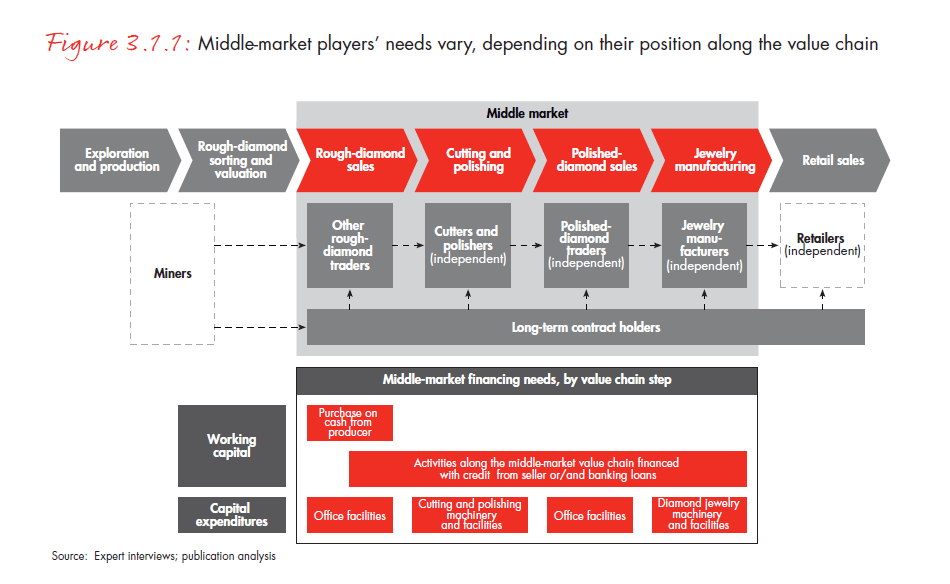
The producers and retailers at either end of the value chain can usually access other financing sources, such as commercial banks and the debt and equity capital markets. And—in contrast to practices in some other industries—producers do not provide trade credit to their buyers, instead requiring payment up front.
We have developed a market model to estimate the size of global diamond financing and disaggregate it by region and financing product. Our methodology consisted of the four steps described in Figure 3.1.2.
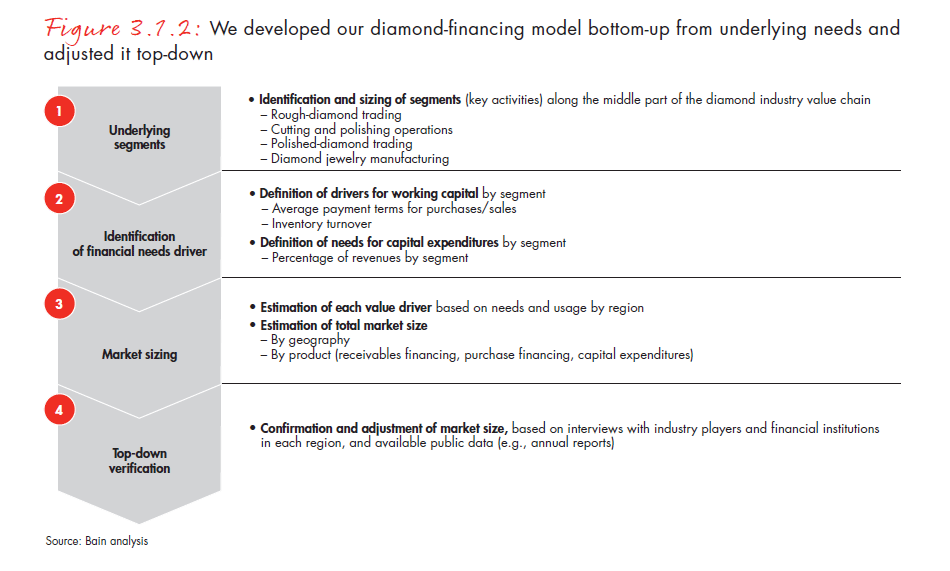
The financing needs of different players along the value chain vary by the structure of their working capital. Rough traders, for example, need mainly to finance purchases of rough diamonds, typically paid for up front. Cutters and polishers, on the other hand, need to finance inventories of stones held for processing. Longer asset-rotation cycles are one of the chief reasons that outstanding middle-market debt has swelled in recent years. Cutters and polishers also need capital to purchase the machinery necessary to their business.
Polished-diamond traders’ financing needs are different. Not only must they finance their inventories, they have a growing need to finance accounts receivable generated by transactions with wholesalers, retailers, and jewelry manufacturers. According to industry participants, these debts are taking longer to collect than in the past. Jewelry manufacturers, too, have a growing need for receivables financing. Their receivables collection times have also lengthened, a reflection of the increased bargaining power of retailers (see Figure 3.1.3).
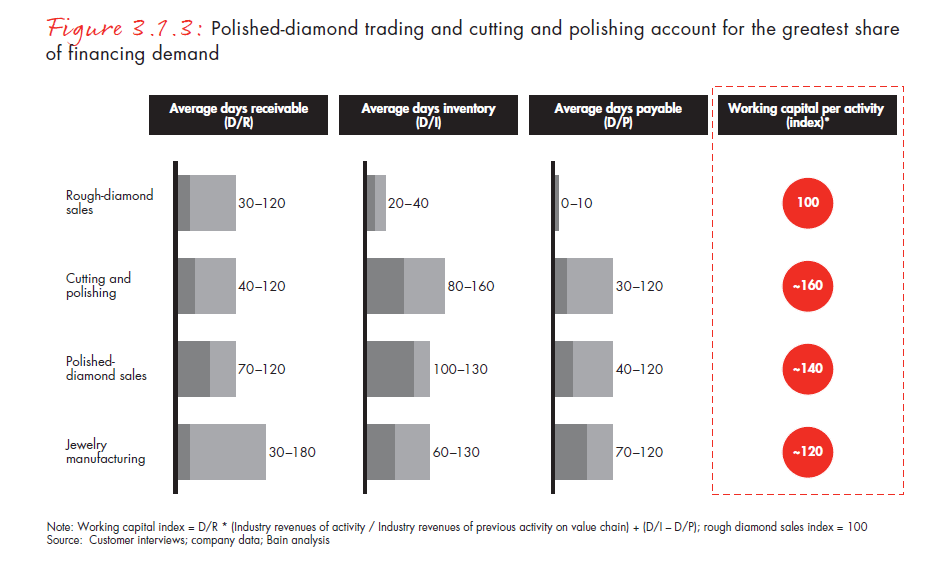
It is in any case difficult to size this market precisely. The borders between diamond financing and other lending instruments have become blurred, starting with the manufacturing segment, where purchases of diamonds represent only a share of the players’ overall cost bases. And it is not particularly helpful to analyze the market by value-chain segment, given the increasing level of integration in the middle market discussed in Chapter 2.
Borrowing in the diamond-financing market is highly concentrated, with fewer than 5% of players accounting for approximately 80% of outstanding debt. The biggest borrowers are also the largest players in the market, such as sight holders and other long-term customers of the producers. As we mentioned in Chapter 2, these players are increasingly integrated along the value chain. The remaining 20% of banking credit is extended to other players in the middle market, including secondary traders and cutters and polishers, which combine banking credit with credit extended by larger traders and self-financing to fund their activities. A third cluster of players, consisting almost entirely of small and medium-size enterprises (SMEs), has no access to the financing market and is increasingly reliant on credit extended by larger traders, which are progressively stepping up their role in financing the industry.
In 2013, the global diamond market accumulated some $16 billion in debt, including about $1 billion in securitizations. India accounted for about 40% of all borrowings. India and Belgium together grew to about 65% of borrowing worldwide from about 55% in 2002. Receivables financing was the most common product, accounting for about 65% of debt outstanding (see Figure 3.1.4).
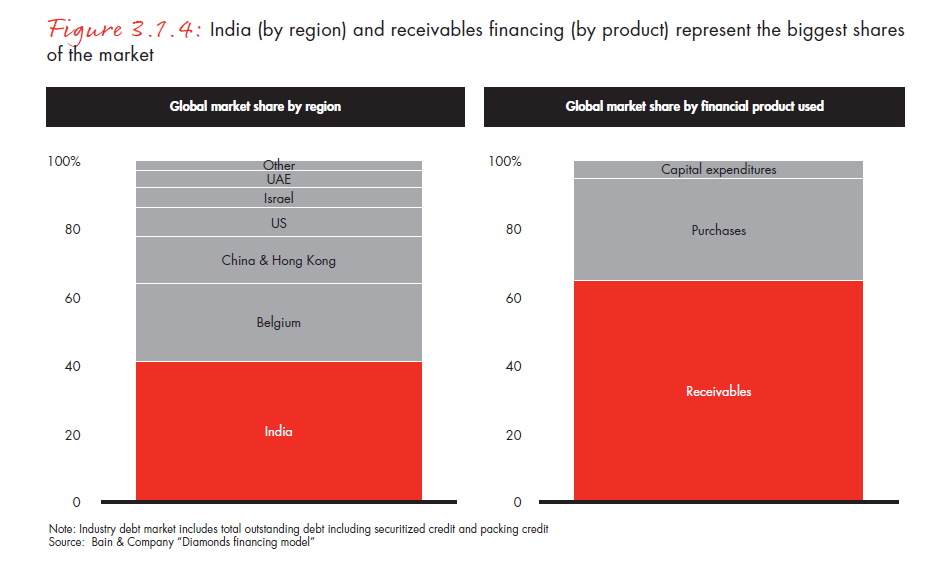
Three main products have evolved to address the middle market’s financing needs.
The first, receivables financing, is implemented by discounting invoices that middle-market players pledge to lenders. This is a low-risk product, because the invoices—that is, the accounts receivable—generate direct payment flows.
The second product, purchase financing, provides cash advances to dealers and manufacturers to enable rough-diamond purchases. In the middle-market segment of the diamond value chain, most banks typically finance individual transactions rather than issue an approved credit line, as in inventory financing. Purchase financing is more risky than receivables financing, and that risk is growing, prompting banks to limit financing to 70–75% of a transaction’s value, compared with 100% in the recent past.
The third group of financing products includes mortgages or term loans needed to finance capital expenditures on office facilities or machinery. In this case, the level of risk depends on the available collateral—that is, whether the borrowing is secured by pledge or by guarantee or is unsecured. Typically, the least risky credits are those issued against pledges of the goods being financed.
Most borrowings are collateralized with a high proportion backed by receivables and to a lesser extent by diamonds, during the manufacturing process and while in inventory. Inventory financing provides more challenges because of the difficulty of appraising polished diamonds. On top of these floating-asset collaterals, borrowers typically offer corporate guarantees. A less common practice is for borrowers to supplement their collateral with hard assets, especially when they are financing capital investments, and personal guarantees issued by borrowers’ shareholders.
In India, lending products and financing modalities differ from those in more developed markets. A product that covers a large share of the Indian market is the packing credit, which is a means of inventory financing; more specifically, the lender extends packing credit to the seller before the completion of asset rotation cycle. Typically the credit is unsecured and more risky than the receivables financing commonly used in other markets.
The typical financial modalities in Belgium, Israel, and the US consist of bilateral transactions between one borrower and one lender. In India, by contrast, lending is usually done through bank consortia. Although somewhat similar to syndicated finance, consortia can specify different repayment terms and conditions for each participating bank.
Geographically, there are six main diamond-finance hubs—Belgium (specifically Antwerp), China (including Hong Kong), Dubai, India, Israel, and the US. Financing demands and products vary by the activities that predominate in each region (see Figure 3.1.5).
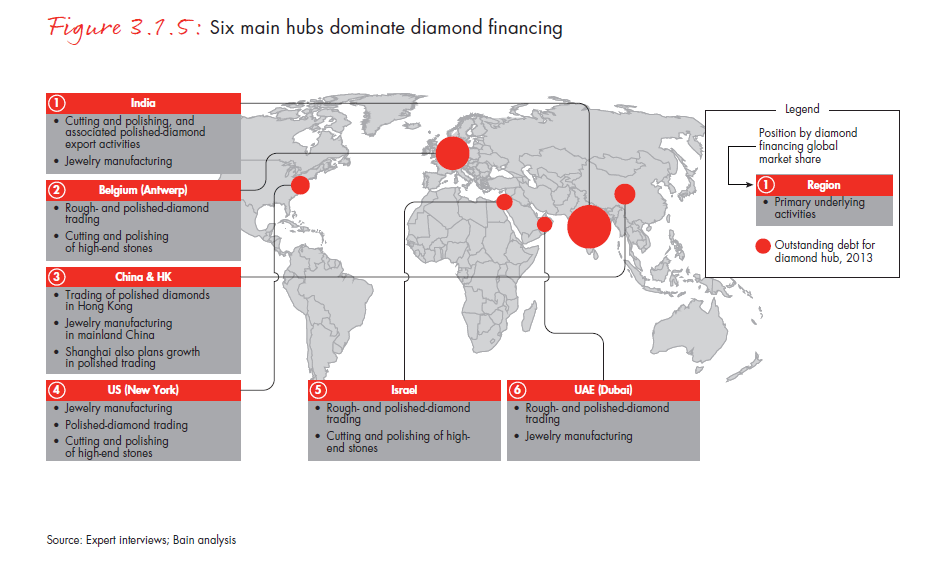
In addition to the traditional diamond hubs, other markets could grow into sizeable centers. As we saw in Chapter 2.1, the industry is pursuing initiatives to spur demand for investment diamonds, such as Singapore’s SDIX, but financing volumes are still very modest.
Historically, a limited number of banks have covered the diamond market (see Figure 3.1.6). The traditional players ABN AMRO Bank and Antwerp Diamond Bank (ADB), a unit of KBC Group, have historically accounted for a significant share of the global market. They both have significant global coverage of the industry from their bases in Antwerp.
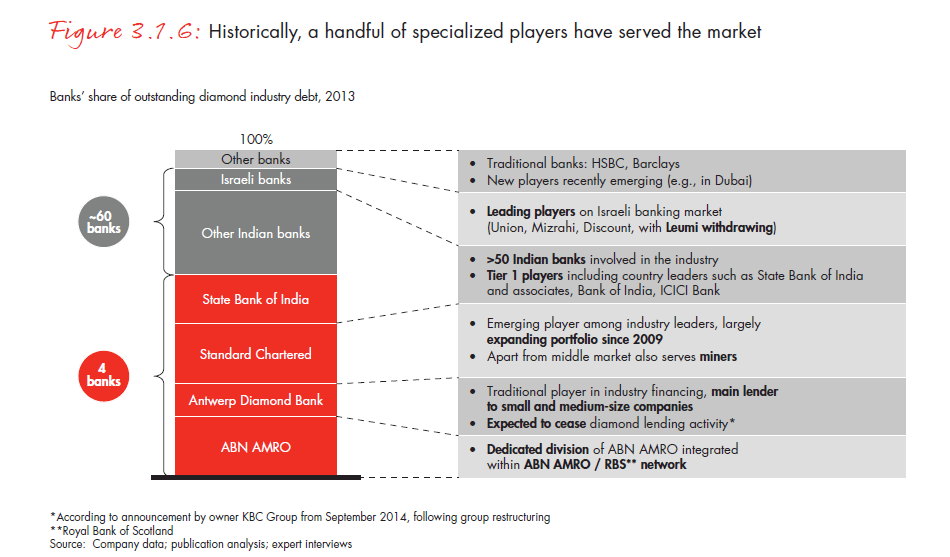
Standard Chartered has more recently emerged as one of the leaders in terms of market share, significantly expanding its diamond-related portfolio in the post crisis period. Standard Chartered covers more segments of the value chain, such as miners, than either ABN AMRO Bank or ADB.
Indian banks are powerhouses of the financing market, accounting for 40% of the global market and 80% of the Indian market. State Bank of India and its regional affiliates hold the largest share, emerging in the past ten years as a significant player globally. A handful of major players, known as Tier 1 banks, dominate the market. These banks are now establishing footholds in diamond hubs such as Belgium (specifically Antwerp) and China. About 50 smaller, Tier 2 banks participate in lending consortia.
Historically, Israeli banks ranked among the leaders in the diamond-financing market, but since the crisis, prominent names such as Bank Leumi, United Mizrahi-Tefahot Bank, and Union Bank of Israel have trimmed their diamond-related portfolios. Declining volumes of cutting and polishing activities in Israel are among the key factors contributing to the cutbacks. These banks have also curtailed their roles in the US market since the crisis.
3.2. The diamond-financing market’s evolution and emerging challenges
Since 2008, the diamond-financing market’s growth has been in the double digits, but challenges have appeared during this period that we expect will accelerate the evolution of the business’s operating model in significant ways.
Diamantaires have increased their leverage as inventory and collection cycles have lengthened and profit margins have narrowed, while banks must contend with increased risk in the diamond industry as well as tighter regulation and industry-wide restructuring.
Diamantaires’ increasing leverage
Since 2002, excluding the crisis year of 2008, the diamond-financing market’s growth has been robust, posting a compound annual growth rate (CAGR) of about 13% before the crisis and a 23% CAGR since 2009. During the same time span, the ratio of debt to the value of polished diamonds (a proxy for the diamond industry’s leverage) grew from about 50% to about 73% (see Figure 3.2.1).
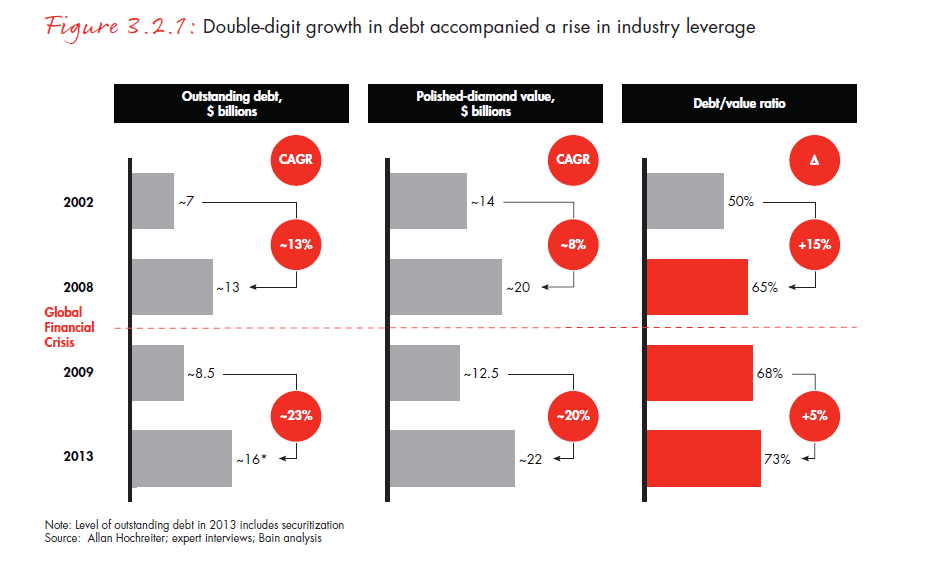
India made the largest contribution to the growth in outstanding debt, accounting for more than $5 billion—or 55%—of the $9 billion total increase. The factors that account for that growth include an increase in underlying diamond activities, especially as India has consolidated its role as a global cutting and polishing center, and a significant increase in the leverage of bank clients. The entry into the market of a new generation of players has contributed to a reshaping of the competitive dynamics. On the one hand, the new players have strived to make their businesses more “corporate”; on the other, the established traders and cutters and polishers lack a high level of retained earnings, a situation that contributes to rising debt levels (see Figure 3.2.2).
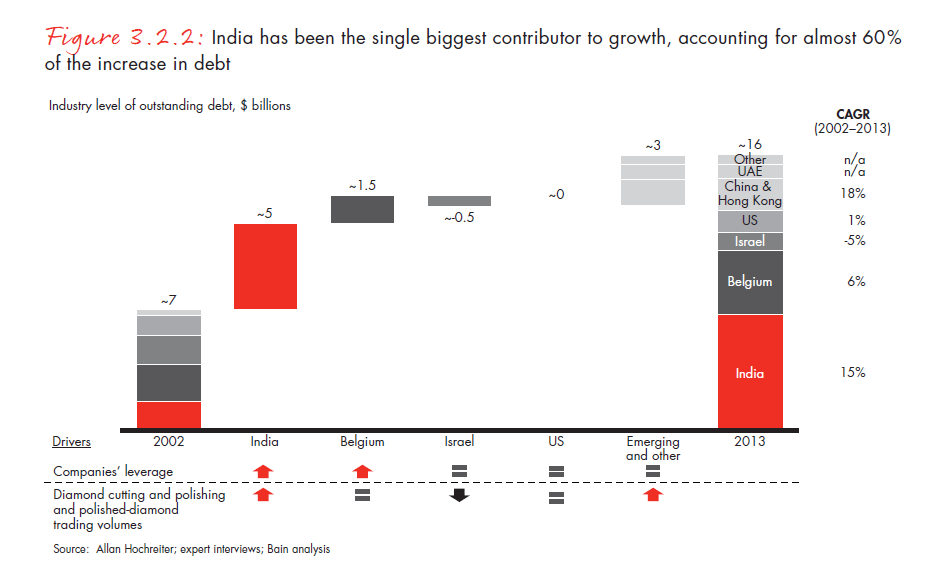
Debt levels have increased in Antwerp as well, though at a slower rate than in India, as customers have added leverage while underlying volume levels have remained stable. Israel and the US have decreased their role in the financing market, consistent with their diminishing role in the middle market.
India has managed to distribute the growth of debt across multiple banks through consortium structures, in contrast to Europe, where the growth of financing volumes remained concentrated within a limited number of main lenders.
An extended value chain
Despite the drive for improved operational efficiency by traders, cutters and polishers, and manufacturers, processing and trading cycles have not been reduced—in fact, they have stretched out in some cases. Since 2013, jewelers, wary of undisclosed synthetic diamonds entering the supply chain, have stepped up their demands for certification of even smaller stones, as discussed in Chapter 2. The certification agencies have increased their capacity but have not kept pace with the increase in demand. As a result, wait times have stretched from two to three weeks to as much as three months or longer (see Figure 3.2.3). What’s more, as retailers have consolidated, their negotiating strength has increased along with their time to payment, which adds to jewelry manufacturers’ working-capital needs. Some US retailers have gone so far as to push jewelry manufacturers to sell some inventory on consignment.
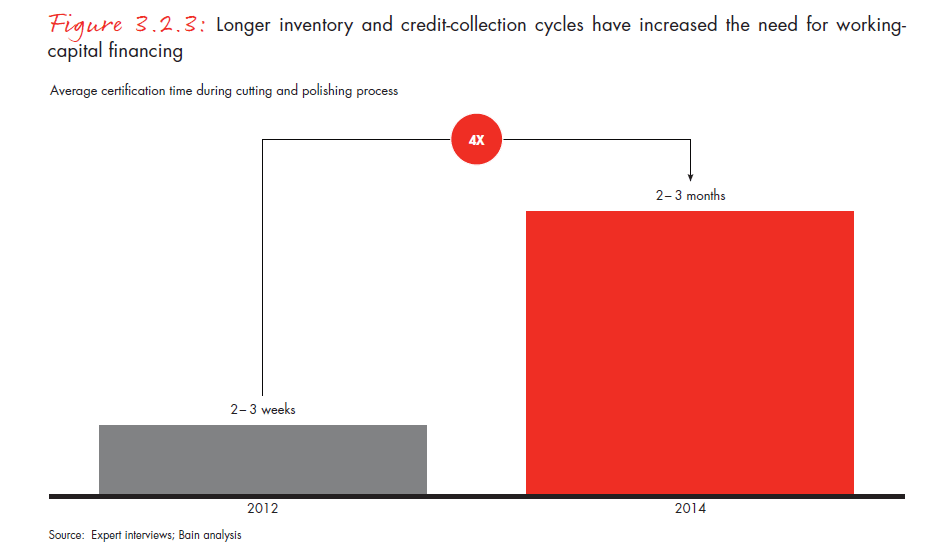
Narrowed profit margins
Since the 2008 crisis, the operating margins of middle-market players have trended downward, to the detriment of their financial fundamentals. Banks have shown little appetite for lending to lower-performing players.
A sharp increase in credit risk
At the same time, credit risk has increased sharply: since the crisis, the ratio of nonperforming loans (NPLs) to total assets rose from less than 1% across the industry to the 4–10% range. Moreover, since 2012, several instances of default have shaken lenders’ confidence that diamantaires are low-risk credits. And it bears repeating that concentration risk has increased, with about 80% of debt owed by fewer than 5% of players and the lending market outside India still limited to a small number of major institutions.
Tighter regulations
The recent evolution in banking regulation, especially the progressive introduction of Basel III rules, has increased the costs of corporate lending, which is expected to rise at a higher rate than the costs of retail banking and trade finance (see Figure 3.2.4). Basel III will progressively tighten risk-weighted asset (RWA) calculation and regulatory capital requirements. We expect that the tighter requirements will take a disproportionately large toll on the SMEs that are the largest component of the diamond middle market.
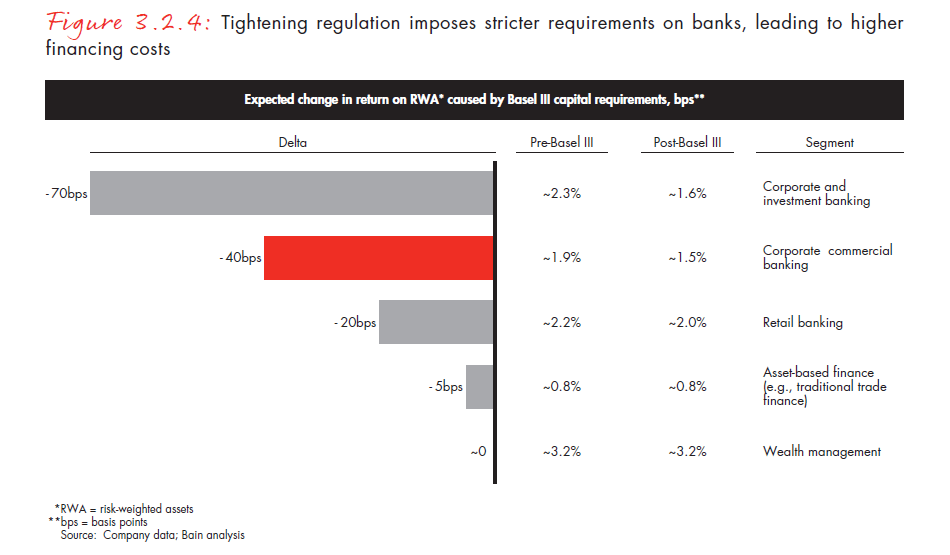
Basel III also introduced leverage, liquidity coverage, and net stable funding ratios, as well as tightened rules governing concentration risk.
More stringent anti–money laundering regulations have added to banks’ reporting and organizational requirements and focused their attention on industries with a high potential to generate reputational risk.
Banking regulators have long maintained vigilant oversight of diamond financing. As regulation has intensified, oversight agencies have progressively increased their scrutiny of diamond-related lending activities, which are perceived to entail high reputational risk. The market’s limited transparency and some players’ questionable behavior have contributed to this trend.
Overall restructuring of the banking industry
The banking industry, especially in Europe and the US, is proceeding with its own restructuring, and in some cases shareholders and other stakeholders have insisted on tighter lending restrictions than regulators have demanded. The main features of this restructuring effort include rebuilding of capital bases eroded by the crisis; tightening of risk standards, sometimes in excess of regulatory requirements; and enhancing risk management capabilities by, for example, adding or fortifying resources, IT platforms, and risk models. As a result, the banking industry, especially in Europe, is deleveraging, with the greatest impact falling on SMEs (see Figure 3.2.5).
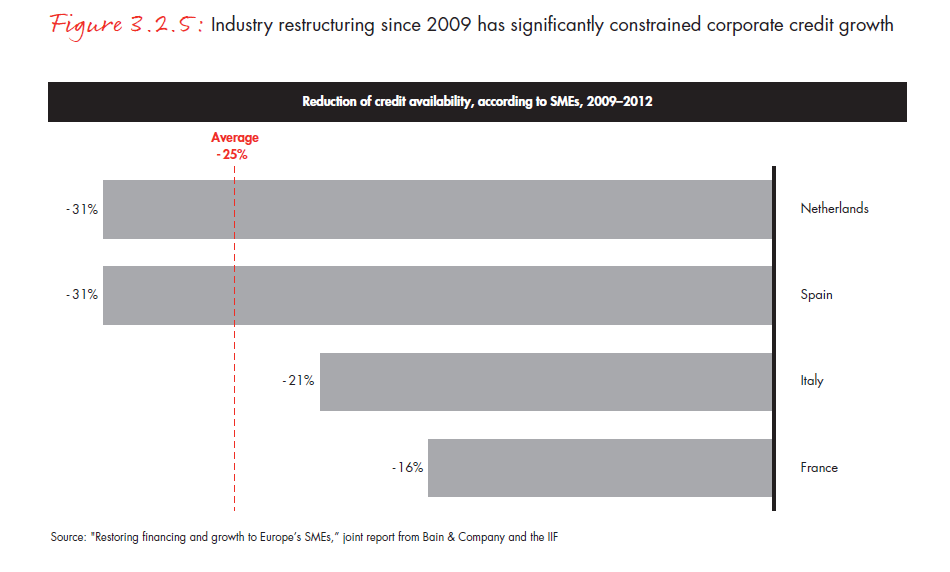
Conditions in other regions differ in varying degrees. Indian banks are already moving toward more conservative credit policies, but the leading players in the Middle East, which are not subject to the constraints imposed by the EU and Basel III, are still busily building up their balance sheets. Banks operating on a global basis are trying to seize similar opportunities in such geographies, although regulatory requirements for consolidated reporting and Basel III credit policies act as constraints. Despite these different regional trends, banking industry participants expect to converge on a common lending approach in the medium to long term.
In this newly cautious and constrained environment, many traditional diamond banks are reducing their exposure to the industry or planning to do so. ABN AMRO Bank, Standard Chartered, and State Bank of India are introducing more prudent approaches to credit. For example, they are reducing the percentage of stones financed to 70–75% from 100%, while tightening borrower solvency ratios. And Israeli banks have reduced their exposure to the overall industry and narrowed their focus to the domestic diamond market.
ADB’s situation is different. Following the crisis, parent bank KBC Group was required to find a new corporate parent for ADB by the end of 2014. After a deal with a prospective buyer, China’s Yinren Group, did not go through, KBC announced that beginning in 2015 it would conduct a gradual, orderly wind-down of diamond-financing operations outside Belgium and merge ADB with its parent company.
In this environment, it is likely that without changes to the industry’s ways of doing business, diamantaires face a period of deleveraging that could see available levels of financing fall by as much as $3 billion in the medium term. Although the deleveraging could help stabilize the market by weeding out the weakest players, it could also reduce secondary trading activity and further constrain credit for the SMEs that now play a key role in supporting the inventory of polished diamonds by spreading risk and adding liquidity.
3.3 Perspective on the market’s future evolution
According to interviews with participants in diamond financing, the industry is considering four approaches to spur evolution of its business model, establish a new equilibrium in the financing market, and sustain the diamond industry’s continued growth. The industry’s immediate priority, beginning in 2015, is to manage the impending deleveraging phase and control the transition to a “new normal” (see Figure 3.3.1).
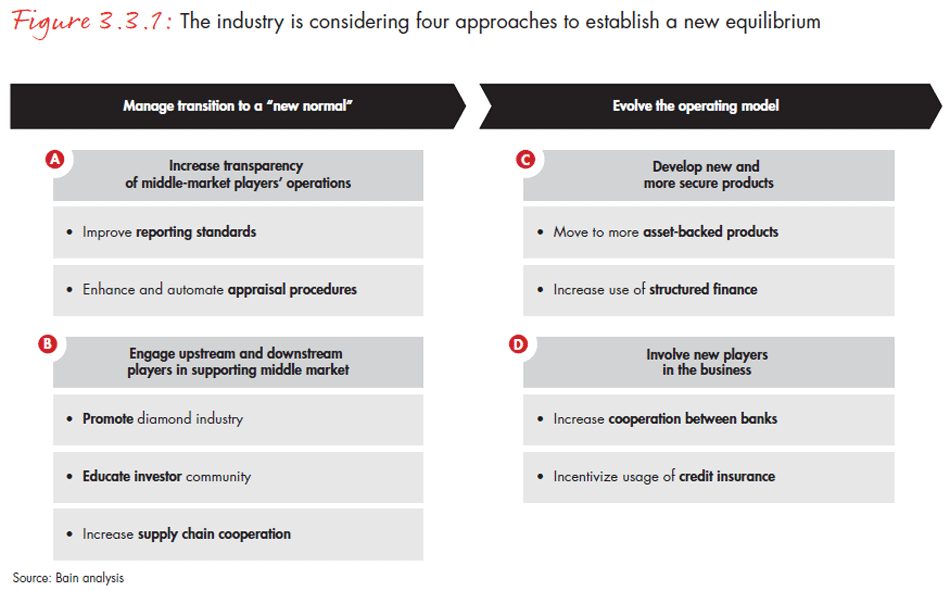
In the short term, to support lenders’ confidence in the diamond industry’s health and prospects, there are two possible courses of action: increasing the transparency of middle-market operations and engaging upstream and downstream players in supporting the middle market.
Additionally, the industry needs to continue the evolution of its operating model by developing new and more secure financing products and encouraging new players to enter the financing business.
Increasing transparency
Diamond industry companies can increase their transparency in two ways. They can improve reporting standards, and they can enhance their inventory appraisal procedures to give banks more confidence in their business.
More transparency in reporting can be achieved by adopting International Financial Reporting Standards reporting conventions, as De Beers will require when it selects its next group of sight holders in 2015. Diamantaires can also make the middle market’s structure more transparent by issuing consolidated annual and semi-annual reports and sharing maps of companies’ consolidation structures. The industry, especially the leading players, has already moved some distance in this direction.
The second key to increasing transparency in industry operations is to enhance procedures for appraising inventories, which at present are opaque to banks. Industry players can do so by disclosing the results of periodic appraisals, introducing tracking and inventory-management processes based on enterprise resource planning (ERP) software, and increasing the involvement of external auditors in the appraisal process.
Some players are already embracing the move to fuller disclosure, ahead of requests from major producers. One major diamond-jewelry player, for example, has been on an extensive modernization drive since 2006. It implemented an end-to-end ERP system to support business processes and track inventories as they moved through the manufacturing pipeline. It also adopted IFRS reporting and subjected its annual reports to external audits. All these undertakings contributed to a reengineered appraisal process that combines transparency with analytical support and facilitates interactions with financing banks, making them aware of their counterparts’ portfolio quality and objective risk level (see Figure 3.3.2).
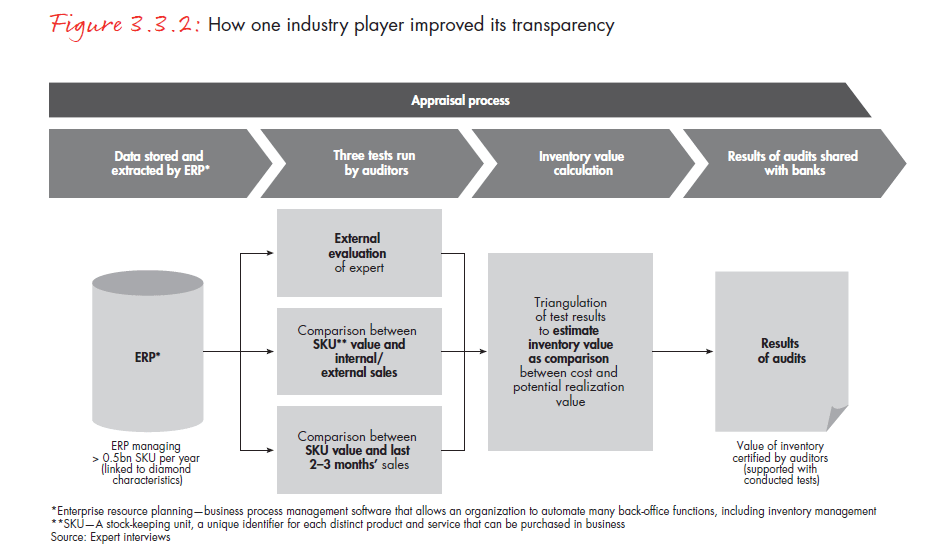
Through such or similar actions, middle-market players can benefit themselves and the larger industry by increasing the transparency of financial figures and methodologies, boosting lender confidence in their reporting. These actions could also serve as a step toward the “corporatization” of smaller players. At the same time, however, investments in new or additional auditors and ERP systems could lead to increasing operating costs, exerting pressure on those players’ margins.
Engaging upstream and downstream players
A second way to manage the transition to this new phase involves more-vigorous engagement by upstream and downstream players in supporting the middle market. They can do so by increasing the investment community’s knowledge of the diamond industry and by working with banks to develop new solutions for financing the entire value chain.
Upstream players could organize road shows to introduce sight holders and strategic partners to the investor and financial community and stage educational events to build knowledge of the industry. Producers could also consider introducing more flexible terms for the sale of rough diamonds, including vendor finance (see Figure 3.3.3). Such actions would improve the financial community’s knowledge of the diamond industry and reduce, if not remove, one of the main obstacles blocking commercial banks’ access to this market.
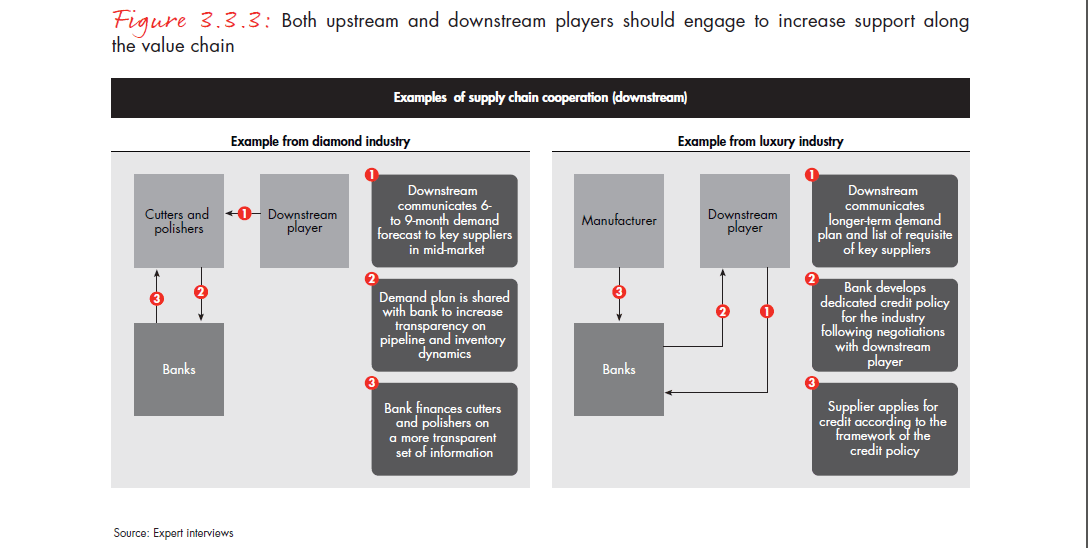
Downstream players could support the middle market by increasing banks’ visibility of pipeline dynamics and the inventory rotations of cutters and polishers. This increased transparency, along with the historically close relationships among retailers and traditional commercial banks, could facilitate the development of credit policies tailored to the unique dynamics of the diamond value chain. Such credit policies could sustain both key clients such as jewelry manufacturers and retailers and their strategic suppliers along the pipeline. As we discussed in Chapter 2, this approach makes particular sense for pure-play retailers that need secure long-term access to jewelry-quality stones through strategic suppliers.
Examples of such support are already appearing. A limited number of downstream suppliers are sharing as much as nine months of their demand plans with strategic suppliers, improving the banks’ visibility of their current and future strategic suppliers’ invoice portfolios.
In the broader luxury industry, we see advanced examples of “triangular” cooperation among downstream players (luxury-goods manufacturers or retailers), middle-market suppliers, and a partner bank. By giving the lender an unobstructed view of the production pipeline through preferred access to production information, including requirements for strategic suppliers, lists of strategic suppliers, and demand plans, the lender can develop a dedicated credit policy for the entire chain. In some cases, this can result in the lenders’ overriding the credit rating of a supplier and upgrading it based on the stronger credit rating of the ultimate manufacturer or retailer.
The actions just described are necessary preconditions for the evolution of the diamond-financing business’s operations. As we mentioned before, the two main levers for achieving this goal are the development of new and more secure financing products and improving credit access for new players.
Developing new and more secure products
The development of new products should aim to reduce the credit risk embedded in the current model of diamond financing and enhance lenders’ comfort with collateral structures. Within the industry, two directions are already under consideration. One of them is a shift to an asset-backed approach from the current financing mode, which differs little from a borrowing base financing but is not directly secured by any assets. In the short and medium terms, this shift can be implemented using a model similar to the one described in Figure 3.3.3 and applied by some of the most advanced players. According to this model, banks focus on loans secured directly (for example, through pledge) by cash-flow-generating assets. Such an approach would not only reduce such risks as loss given defaults but also shift the credit analysis from company financial ratios to asset quality.
Another direction is taking further steps to developing more sophisticated product portfolios and lower credit risks include increasing the penetration of structured finance products, such as the creation of special-purpose vehicles. These vehicles typically contain diamond loans and enable banks to transfer part of their credit risk and minimize the loans’ impact on RWA. They also provide other institutional investors, such as asset managers, the opportunity to diversify their portfolios by investing in short-term products that offer yields comparable to, if not better than, those on other short-term instruments.
Involving new players in the market
There are several options to facilitate the participation of new players such as traditional commercial banks in the diamond- financing market. Two of the most compelling are to encourage increased cooperation among traditional diamond banks and commercial banks and to reduce credit risk by developing credit insurance products.
India’s diamond-lending consortia provide one example of increased cooperation among traditional and corporate banks. Widespread introduction of this system could enable lenders to distribute risk more broadly among themselves and to rationalize credit analysis efforts. Such a move could give newcomers to diamond lending the time they need to learn the business before stepping up as independent players.
Credit insurance products can also be used to increase collaboration. These products facilitate the collection of accounts receivable through insurance on the credit and sometimes also support the credit collection process. Insurance issued in favor of a diamond player reduces portfolio risk, thus enabling the bank to offer better loan conditions.
Alternatively, by directly insuring its portfolio, a bank might be able to reduce RWA and thus its capital requirements, although in the past some supervisors have balked at accepting this approach. The main constraints on the further penetration of credit insurance are the cost of the product, which can be material when issued in favor of a smaller company, and the minimum ticket available for financing, which would require the development of solutions to pool receivables from multiple players, a practice known as receivables pooling.
Judging from the increased number of new players in the diamond-financing market, some commercial banks have already taken notice of the industry’s efforts. In Dubai, a few commercial banks, including Emirates NBD, Mashreq Bank, and National Bank of Fujairah, recently entered the diamond-financing market. They usually operate in partnership with the traditional diamond banks, but industry observers expect that their direct exposure could increase over time. In India, YES BANK and IndusInd Bank have introduced tailored solutions for gem and jewelry manufacturers and exporters. The move represents a step up from participation in consortia to more independent roles. In Africa, Barclays recently provided credit for the establishment of cutting and polishing centers in Botswana, joining a group of South African commercial banks already active in the area. In Southeast Asia, local banks are expected to increase their exposure to the industry, given the interest of Singapore in playing a more prominent role in the diamond market.
At present, limited transparency and lack of understanding of the dynamics of the middle market of the diamond value chain make it difficult for commercial banks to serve the industry; in some cases, these factors lead them to overprice the industry’s risk. Full transparency and sterilization of credit risk, however, could enable commercial lenders to play a more prominent role in the market. More players—and more-diversified players—would reduce banks’ funding costs and concentration risk, which in turn would enable them to offer more competitive rates and lower the concentration risk of all participating banks (see Figure 3.3.4). Many industry experts estimate that wider participation by commercial banks in diamond financing would benefit the entire industry by providing increased access to liquidity on potentially better terms than those that prevail at present.
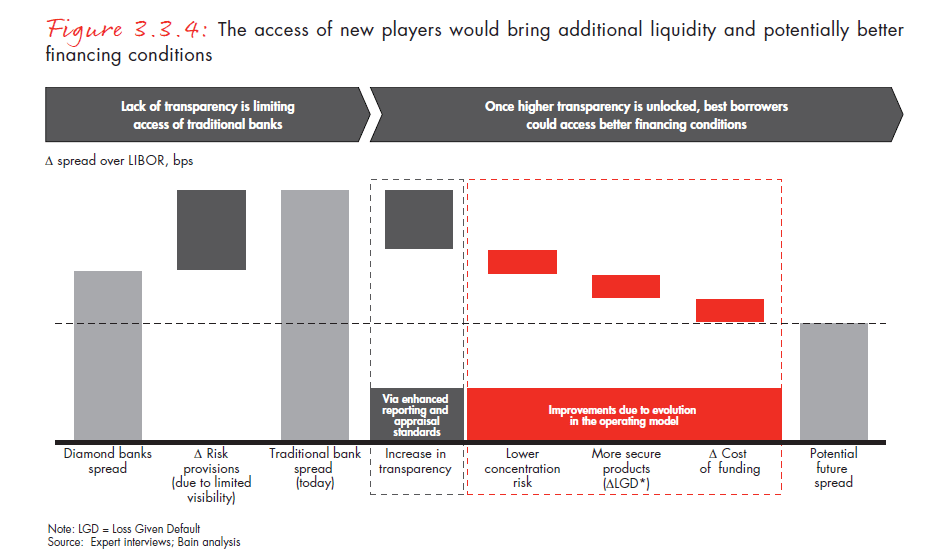
Overall, the diamond industry has a positive outlook, with a sound long-term demand growth forecast and a growing level of integration and “corporatization” among its players. For all stakeholders to capture the opportunities generated by such growth, the industry must encourage closer cooperation among diamantaires, banks, and other players along the diamond value chain. The industry should also improve the quality of its collaterals, which could increase the use of asset-backed products. Only by cooperating can they implement a new and more sustainable operating model.
3.4 Key takeaways
- The term diamond financing refers to bank financing of the key business needs of the middle-market players.
- Three major products have evolved to meet the industry’s financing needs: receivables financing, financing of diamond purchases, and mortgages or term loans to support capital expenditures on machinery.
- Over the past decade, the industry’s outstanding debt has more than doubled. It is estimated at about $16 billion in 2013, including $1 billion in securitizations. Receivables financing accounts for more than 65% of the market. India alone accounts for more than 40% of lending, and Belgium, specifically Antwerp, is the second-largest market.
- Historically, a limited number of financial institutions served the diamond market. They include diamond banks such as ABN AMRO Bank and ADB, as well as Standard Chartered, which recently emerged as one of the leaders by market share; more than 50 Indian banks, among which State Bank of India holds the highest share; and Israeli banks, which have reduced their role since 2008.
- Since the crisis, several challenges to the industry have emerged
- Industry leverage has increased significantly, largely as a result of increased borrowing by cutters and polishers and manufacturers in India.
- Increasing stone certification has improved market transparency and boosted consumer confidence. At the same time, however, long waiting periods for certification have stretched the supply chain. In parallel, the increasing bargaining power of retailers has produced unfavorable payment conditions for their suppliers, such as jewelry manufacturers.
- The margins of middle-market players have come under pressure.
- The industry’s credit risk has risen as the ratio of nonperforming loans to assets has swelled from less than 1% to the 4–10% range.
- Tighter bank regulation, especially in the form of Basel III, has taken a disproportionate toll on corporate banking and SMEs.
- The banking industry, especially in Europe and the US, has undergone a broad restructuring and in some case deleveraging, especially in the SME segment of their portfolios.
- These challenges are spurring leading lenders to adopt more-conservative credit policies, pushing the diamond-financing industry to deleverage.
- There are four potential actions for the industry to consider to establish a new equilibrium and contribute to the evolution of the operating model for diamond financing:
- In the short term, it is crucial to increase transparency of company operations for middle-market players, by, for example, improving reporting standards and enhancing and automating inventory appraisal procedures.
- Also in the short term, upstream and downstream players can take steps to support the middle market. Upstream players can organize road shows and other educational events; downstream players can coordinate “triangular” cooperation among retailers or manufacturers, their banks, and their strategic suppliers.
- In the medium term, new and more secure products—including structured finance and traditional trade finance structures—could be introduced.
- In the medium term, traditional commercial banks could be encouraged to enter the market through closer cooperation with diamond banks.
- The access of new players to the market would benefit both diamantaires, which would have access to a wider range of financing opportunities, and banks, which would be better able to diversify their risk exposure.
- The outlook for the diamond industry overall is positive. For all stakeholders to capture the opportunities created by such growth, banks and diamantaires must cooperate more closely and develop more-secure products.
4. Updated global supply and demand model
The diamond market continues to surprise observers with its ability to rebound from short-term ups and downs. Barring major shocks in the coming few years, supply and demand are projected to grow at different rates between now and 2018. In the period from 2019 through 2024, rough-diamond supply is projected to decrease, as existing mining assets are depleted and overall production slows because of limited additional capacity. Demand, however, is projected to maintain a robust growth rate, thanks to strong fundamentals such as expanding wealth and a growing middle class in developed and developing countries alike. In addition, growth in demand could intensify even further if consumers in Latin America, Africa, and Russia and Asian countries other than Japan and China show increased interest in diamond engagement and wedding jewelry and if they significantly increase the share of diamonds in their jewelry purchases.
4.1 Global rough-diamond demand forecast: Methodology
The demand forecast for rough diamonds hinges on consumer demand for diamond jewelry. Our forecast therefore factors in data on the forces that historically have shaped demand for diamond jewelry. These forces include GDP growth, the size and growth of the middle class, and diamonds’ share—especially diamond engagement rings’ share—of the overall jewelry market.
We then identified the indicators that, in our view, best explain the differences in consumption of diamond jewelry in each region. We forecast demand based on those indicators, factoring in the historical correlation between the indicators and final demand (see Figures 4.1.1 and 4.1.2).
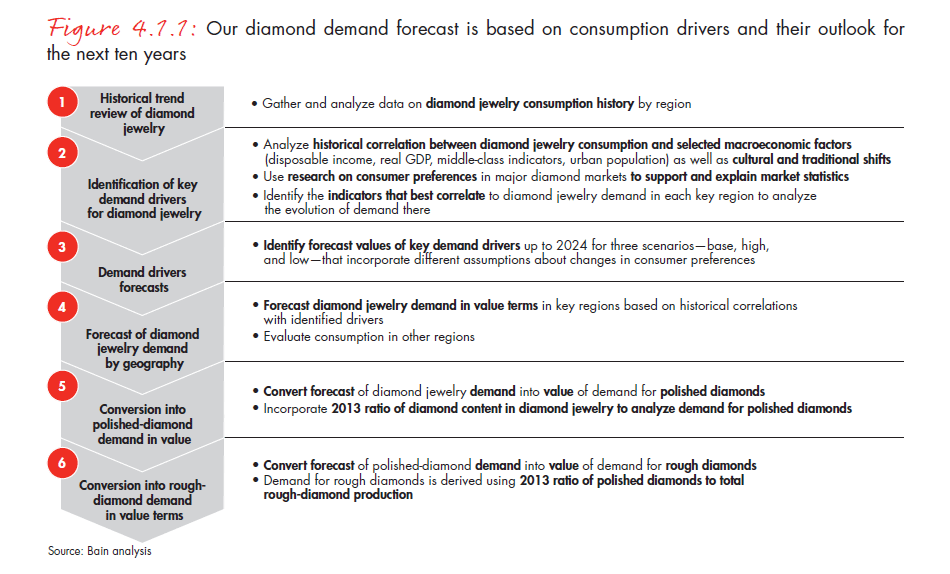
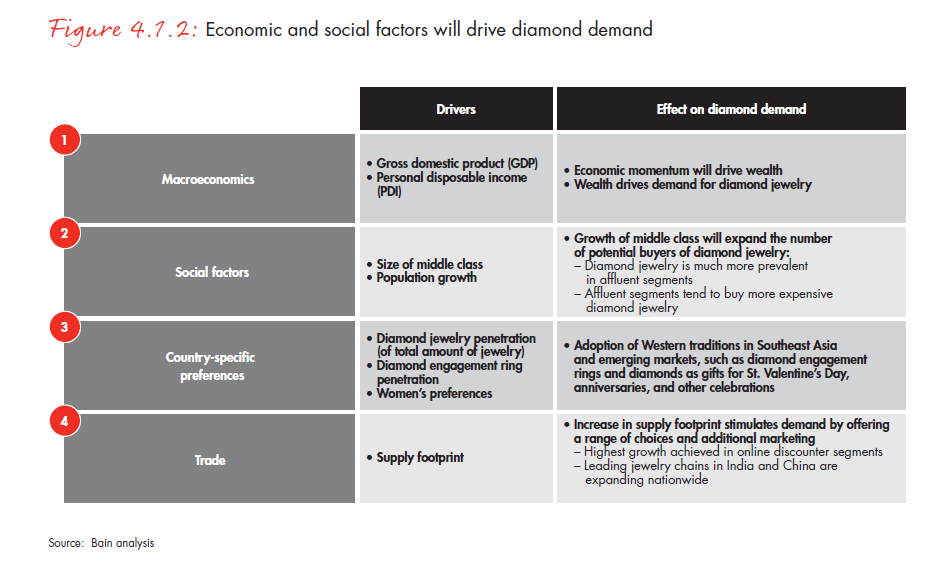
The link between demand and personal income
In developed regions such as Europe and the US, where diamond markets have matured, and in the growth area of the Persian Gulf, a key driver of diamond consumption is disposable income. As personal wealth grows, consumers in such markets tend to take their diamond purchasing to the next level—buying, for example, additional jewelry or jewelry with bigger or higher-quality stones.
To forecast diamond demand in these regions, we analyzed GDP and disposable income projections for each region (see Figure 4.1.3). The analysis also considered shifts in consumer preferences that could affect cultural practices related to engagement and marriage, as well as diamond jewelry’s share in gift giving and personal consumption. We also examined economic development patterns to define potential high- and low-consumption scenarios in these regions.
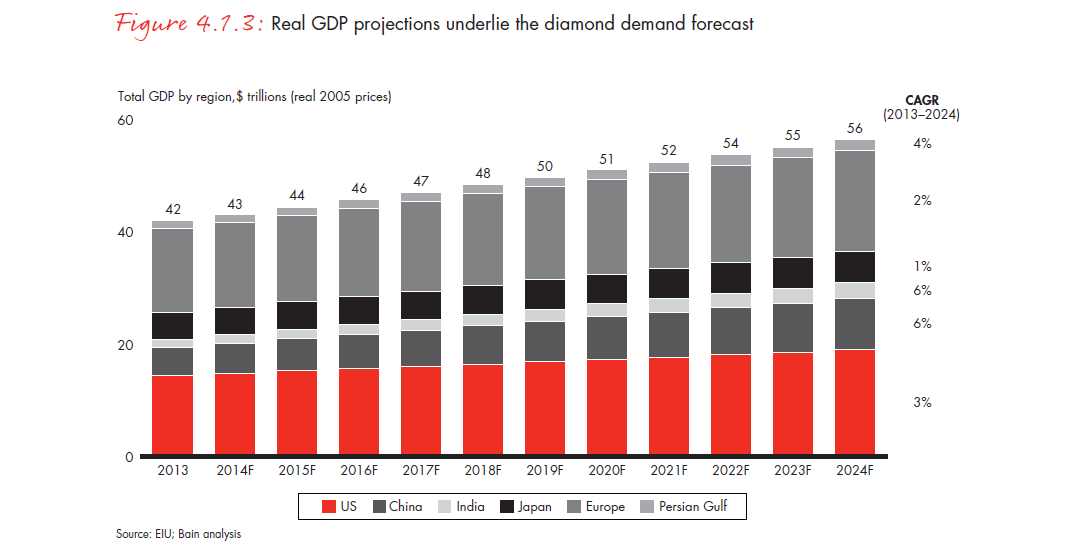
In China and India, demographics are changing quickly, and personal preferences regarding diamond jewelry are still taking shape. To forecast demand in China and India, we examined trends including urbanization and middle-class and overall economic growth, along with the impact of retailers’ and industry associations’ marketing campaigns and retailers’ further expansion into less urbanized areas, including small cities as well as rural communities.
As the middle class expands in the developing world, retailers will seize the opportunity to serve these consumers by setting up new stores and online shopping channels (see Figure 4.1.4). Brick-and-mortar and on-the-line stores will require enough inventory to offer a broader choice of diamonds to consumers. Once they have opened their new stores, retailers will prime the diamond-purchasing pump by launching marketing and advertising campaigns.
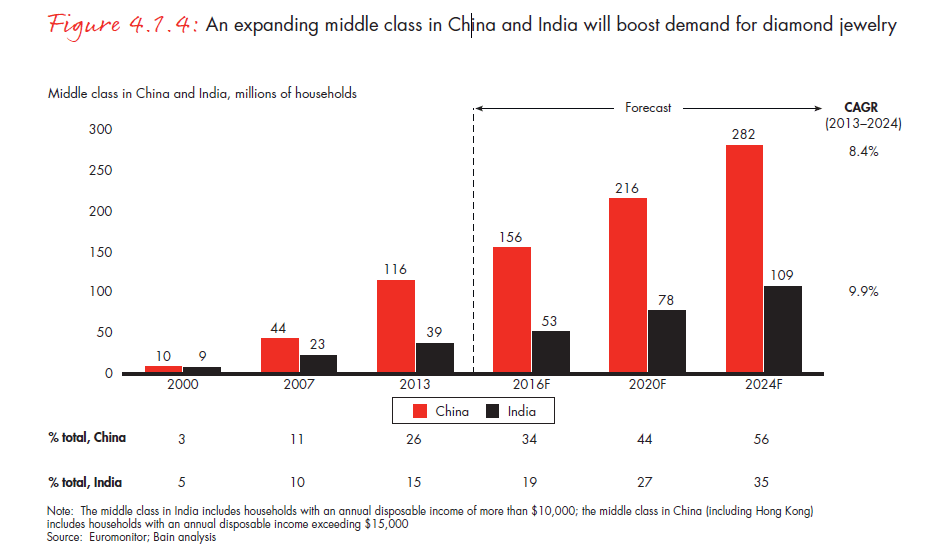
4.2 Global rough-diamond demand forecast: Base scenario
Growth in line with historic trends
We expect demand for rough diamonds over the next decade to grow in line with historical trends, influenced by the speed of economic recovery in Europe and the US from the most recent global downturn, China’s and India’s ability to sustain high-single-digit GDP growth and expansion of their middle class, an increase in private consumption, and continued adoption of Western cultural traditions in developing markets.
Marketing campaigns by jewelry retailers, industry associations, and other value-chain players can play a major role in supporting the diamond market’s growth story. As we discussed in previous chapters, players are already teaming up to promote diamonds.
In the base scenario, we have incorporated forecasts for key regions around the world. Drawing on those forecasts, we expect rough-diamond demand to grow by 2024 at an average annual rate of 4–5% (see Figure 4.2.1).
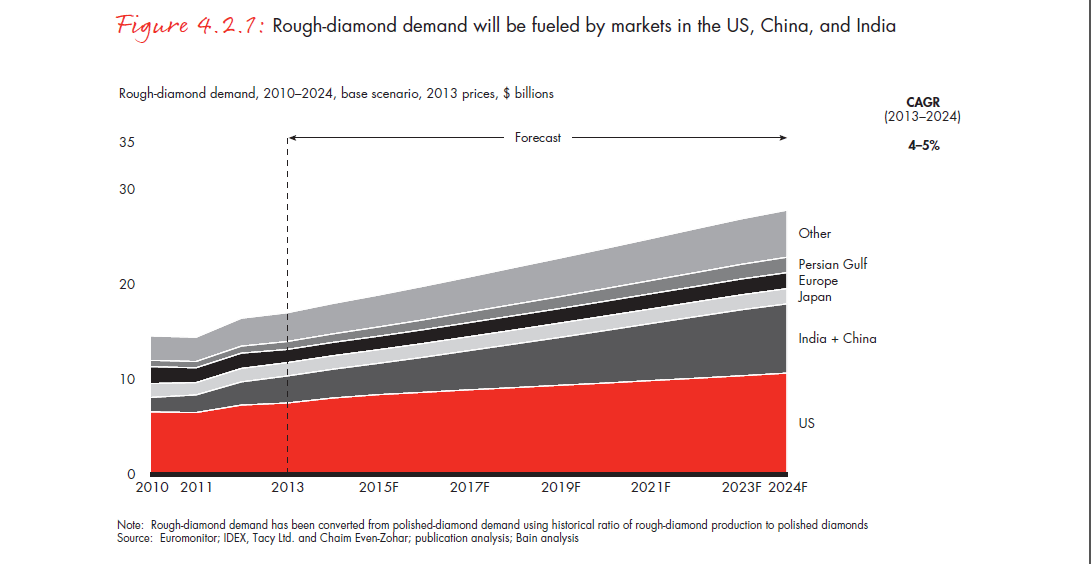
Demand forecasts for key regions
China, India, and the US will account for the majority of growth in diamond jewelry consumption in the next ten years.
US
In the short term, diamond consumption in the US is expected to continue its current rebound trend of the past few years, before gradually converging with its historical long-term growth rate in line with GDP and disposable income growth. We anticipate no major shifts in cultural norms regarding engagement and wedding jewelry. Personal disposable income growth through 2024 is forecasted at about 2.6%; the population is expected to grow moderately at about 0.7% per year through 2024.
China
In China, the diamond jewelry market is expected to sustain strong growth, owing to continued expansion of the middle class, a rising urban population, and increases in personal wealth. Diamond demand is projected to more than double by 2024, thanks to continued robust GDP growth, which further supports middle-class growth. The number of middle-class Chinese households is expected to increase by 2.5 times in the next ten years. Middle-class households claim a relatively small percentage of total households (about 26%), but the latest analysis suggests that that percentage could reach up to 56% in 2024.
In China, GDP and personal disposable income (PDI) growth will determine middle-class growth. PDI is projected to see a CAGR of 6-7% through 2024. Meanwhile, urban population growth is expected to grow at a compound annual rate of about 2% over the same period.
India
India’s story is similar to China’s. Following the stabilization of the currency situation in India, the diamond jewelry market there is expected to revert to high-single-digit growth. Economic growth is expected to pick up again, and India’s middle class is expected to grow 2.8 times by 2024, driving demand for diamond jewelry. Middle-class households constitute only about 15% of total households, as they have over the last three years. But our analysis suggests that the number could rise to 35% in 2024.
In India, middle-class growth will follow workforce growth and increased labor-force participation as the nation switches from a natural to an organized economy and more of the population joins the labor force. The Indian luxury-goods market has not yet achieved its full potential, presenting significant upside for growth in diamond demand powered by GDP growth and improvement in consumer welfare. The penetration rate of diamond jewelry is expected to increase as well—relative to gold products—owing to increased interest in the giving of diamond rings as an engagement ritual.
4.3 Global rough-diamond demand forecast: Two alternative scenarios
Our demand forecast includes two alternative scenarios that result in higher or lower diamond demand (see Figure 4.3.1). Both scenarios also take into consideration the projected growth in high-net-worth individuals (HNWIs) and the development of the overall luxury-goods market (see Figure 4.3.2).
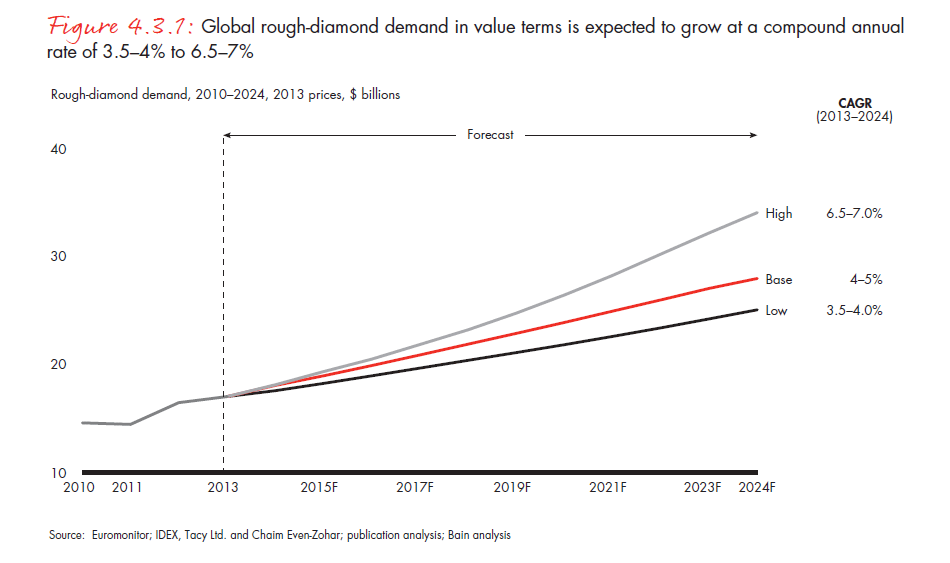
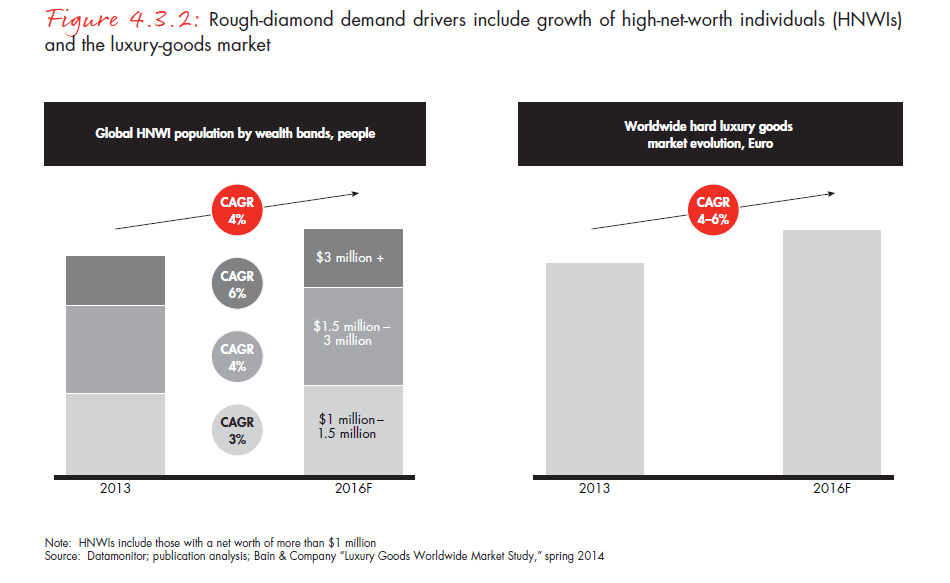
The higher-demand projection for rough diamonds assumes stronger GDP growth in developed countries, which in turn drives up total private consumption and diamond spending. In China and India, this scenario assumes higher rates of growth in the number of middle-class families and faster adoption of Western culture than in the past.
The lower-growth scenario inverts those assumptions and anticipates slowing global GDP growth and a relapse into global recession. Under that scenario, developed economies would stagnate and growth rates in China and India would decline, though they would remain higher than growth rates in developed economies.
4.4 Global rough-diamond supply forecast: Methodology
We have revised our 2014 annual supply forecast on the basis of the updated plans of mining companies and reports on the progress of several mining projects. As in 2013, we drew our base forecast for the global rough-diamond supply from an analysis of current and historical production levels at existing mines, combined with publicly announced plans and anticipated production at every new mine expected to come online from 2014 through 2024 (see Figure 4.4.1).
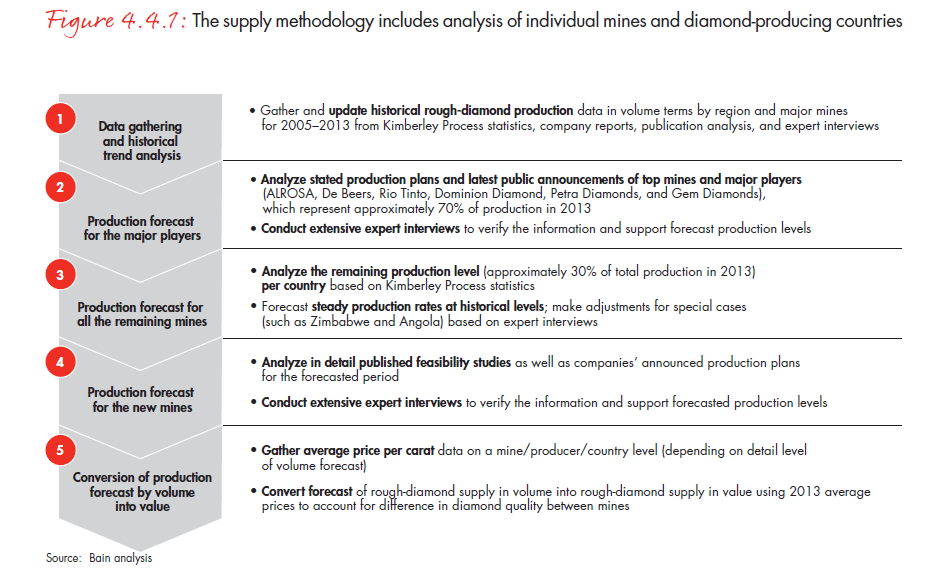
For each major mine and producer (which collectively accounted for 70% of global rough-diamond production in 2013), we looked at operating companies’ production plans. We also analyzed the additional production from other mines—roughly 30%—on a country-by-country basis. For new mines, we forecast production by consulting published feasibility studies and production targets. Although we relied primarily on the publicly disclosed plans of producers and mine operators, we also drew on expert opinion when updated company plans were not available or when a majority of experts judged a plan to be overly optimistic. Several considerations can influence that judgment, including technical or financial difficulties and uncertainties associated with the engineering challenges inherent in moving from surface to underground extraction.
In addition, as we do every year, we allowed for uncertainty regarding the output of several mines and producing countries by constructing two alternative additional scenarios, which we label the Stable Production Scenario and the Increased Production Scenario. Each scenario draws on technical experts’ opinions and market research to envisage potential variations in expected future production.
4.5 Global rough-diamond supply forecast: Base scenario
Our base supply scenario calls for moderate growth in the supply of rough diamonds. It assumes that new mines now under development will add 20 million carats to the supply and takes into account a slight depletion of existing diamond resources and absence of significant new discoveries of diamond deposits in recent years. The resulting forecast calls for rough-diamond production to reach 163 million carats in 2019, below the precrisis production of 177 million carats in 2005, which dropped to 163 carats by 2008.
New mines coming online
The base scenario draws from analysis of companies’ published plans regarding their current and future production levels. In addition to existing mines, 14 new mines are expected to begin production or ramp up to full capacity by 2024 (see Figure 4.5.1).
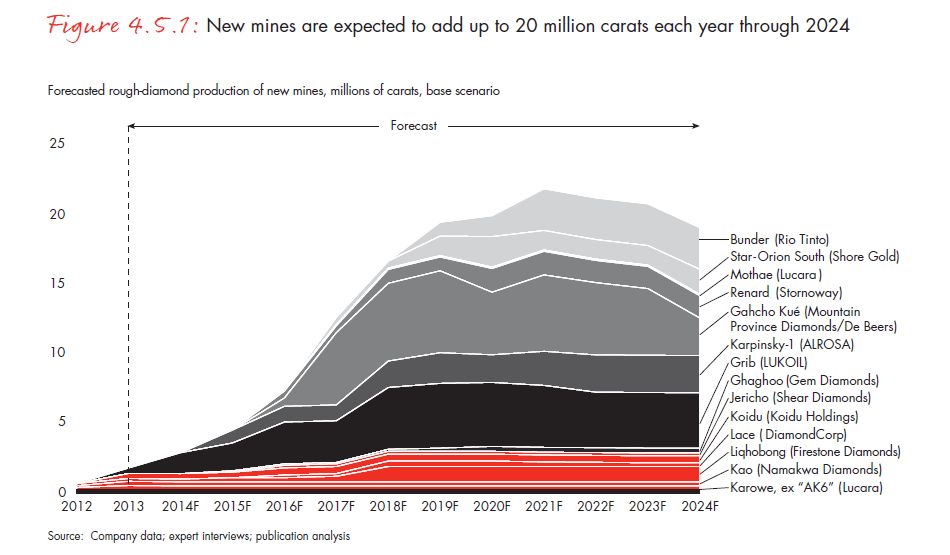
The largest mine expected to come online is the Gahcho Kué mine in Canada’s Northwest Territories. Developed by Mountain Province Diamonds and De Beers, Gahcho Kué is projected to produce up to 5 million to 6 million carats annually through 2020. ALROSA’s development of the Karpinsky-1 pipe at the Lomonosov diamond field is expected to yield about 3 million carats annually. Rio Tinto’s Bunder mine in central India is projected to yield roughly 3 million carats annually when it comes fully online in 2020 or 2021.
With the exception of Russia’s Grib mine and Canada’s Renard mines, which are projected to produce 4–4.5 million and 1.5 million carats per year, respectively, other new mines under development are relatively small; each is projected to produce 1 million or fewer carats annually. Most of the new mines have encountered technical challenges and have had difficulty attracting financing in the current uncertain macroeconomic environment.
The 14 new mines could collectively generate about 20 million carats in annual production by 2024—a modest amount relative to current global rough-diamond production. Because it takes seven to ten years to develop a mine, even if major new deposits were discovered within the next few years, there would not be enough time to bring them to full production by the end of the forecast period.
Global supply assumptions
Taking all these factors into account, the base scenario calls for the global supply of rough diamonds to grow by a compound annual growth rate in the range 3.5–4.0% during the 2013–2019 period and then to decline by 1.5% to 2.0% from 2019 through 2024 (see Figure 4.5.2). This long-term supply decline will derive from the aging of existing mines combined with a shift of production to underground mining.
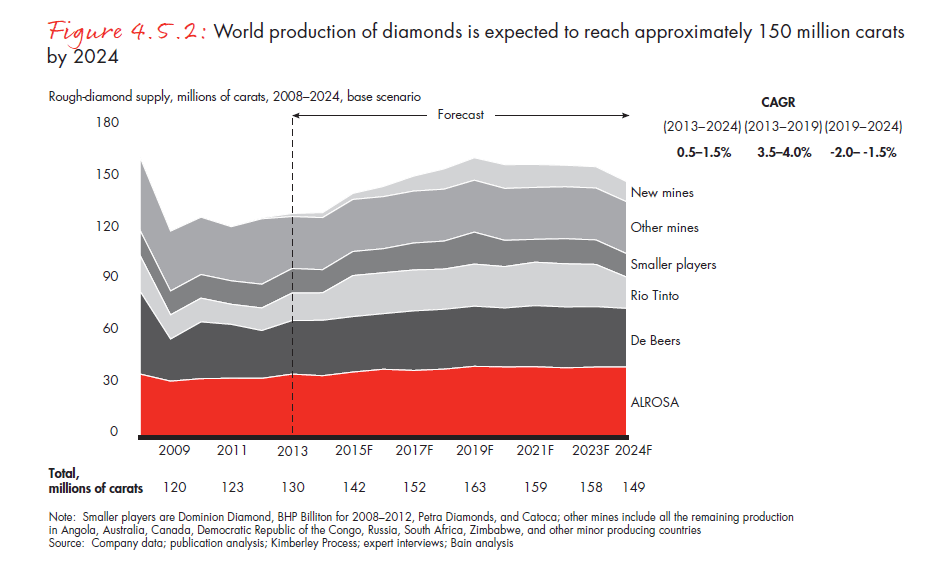
Our 2014 supply forecast calls for slower growth in supply than did the 2013 forecast. This year’s forecast reflects changes in producers’ plans as well as financial and operational difficulties experienced by some mines. Actual 2013 output was 6.3 million carats lower than forecast in our 2013 projections. According to Kimberley Process statistics, the Democratic Republic of the Congo reported 5.8 million fewer carats than the previous year. Zimbabwe fell short of 2013 expectations by 1.7 million carats. Angola reported a reduction of 0.9 million carats.
Partially compensating for the lower output from African mines, the revised forecast for Debswana’s (joint-venture between De Beers and the Government of Botswana) Orapa mine in Botswana calls for 2 million more carats produced per year through 2023 than the company forecast in 2013. Our revised forecast also anticipates that Rio Tinto’s Argyle mine in Western Australia will produce 2 million more carats per year through 2020 because of revised assumptions regarding the mine’s output after the shift to underground operations.
Finally, as we noted earlier in this report, not all carats are created equal. Diamonds from Zimbabwe and the Democratic Republic of the Congo tend to be of lower quality than equal-weight diamonds from other regions. To account for variations in diamond quality, we used each mine’s average price per carat to project future supply in dollar terms (see Figure 4.5.3).
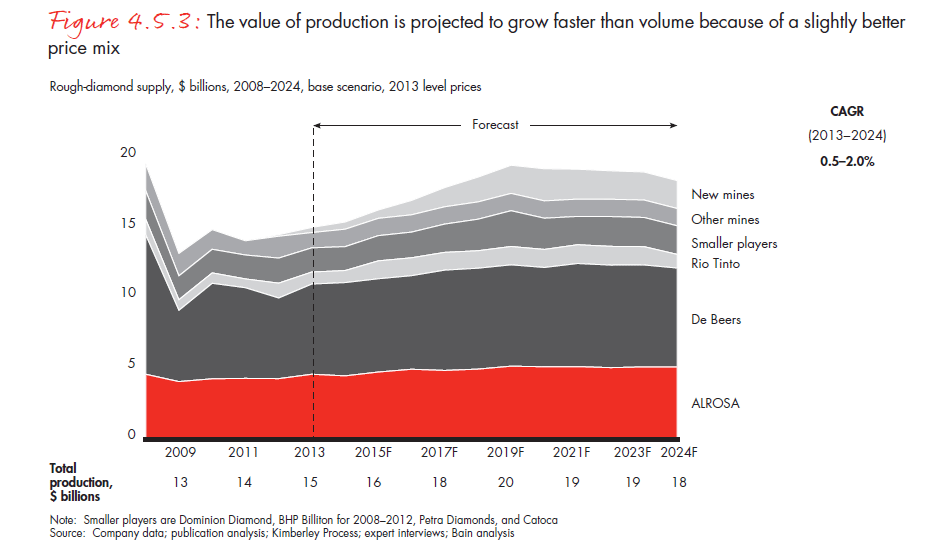
4.6 Global rough-diamond supply forecast: Two alternative scenarios
We constructed two alternative supply scenarios to allow for the possibilities that production will grow at a greater or lesser rate than that assumed in the base supply scenario (see Figure 4.6.1). As in our 2013 report, these alternative scenarios take into account the feasibility of additional supply in some African countries as well as the potential for the largest mines and producers to fall short of their stated production targets. Both scenarios factor in potential developments within the industry as well as external factors that could disrupt mining activities.
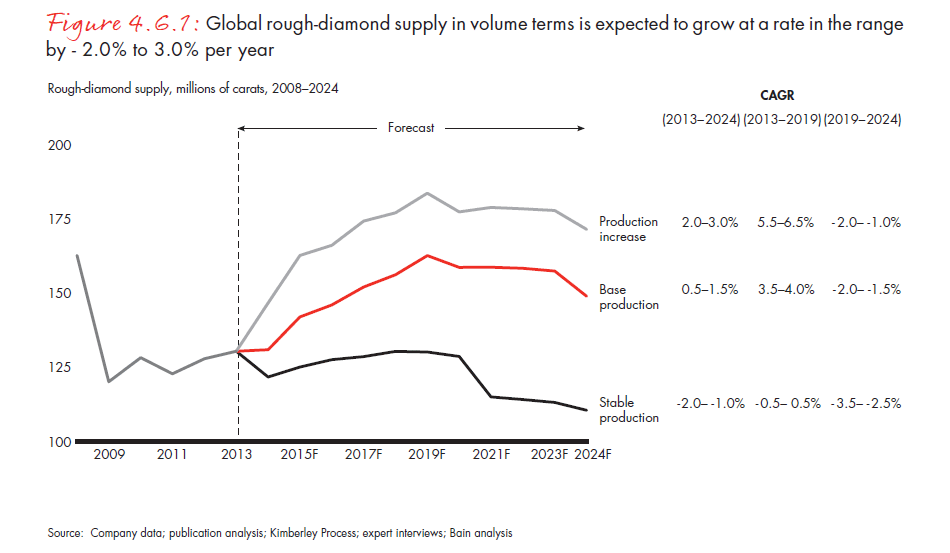
The Production Increase Scenario envisions additional production increases based on expert interviews and opinions. This scenario calls for production to grow at a 2.0–3.0% compound annual rate from 2013 through 2024, compared with 0.5–1.5% in the base scenario.
The Stable Production Scenario is based on more conservative assumptions, most notably the possibility that some major mines will achieve their full potential more slowly than assumed in the base scenario. According to this scenario, a weak economic environment and technical complications will cause some mines to produce less than projected under the base scenario. This scenario assumes that production will remain flat until 2019 and then decline by 2.5–3.5% from 2019 through 2024. Overall, under this scenario production will decline by 1.0–2.0% from 2013 through 2024, rather than increase 0.5–1.5% over the same period, as the base scenario predicts.
4.7 Global rough-diamond supply-demand balance, 2014–2024
Bain & Company’s 2014 forecast projects that from 2014 through 2018, the demand growth rate will exceed that of supply. Starting in 2019, we expect the difference between the growth rates to widen by up to 6 percentage points. Demand is projected to continue its long-term growth trajectory, supported by the outlook for strong market and economic fundamentals, and supply is projected in line with the reduction in global production levels. This trend, if sustained, suggests a long-term positive outlook for the diamond industry (see Figure 4.7.1).
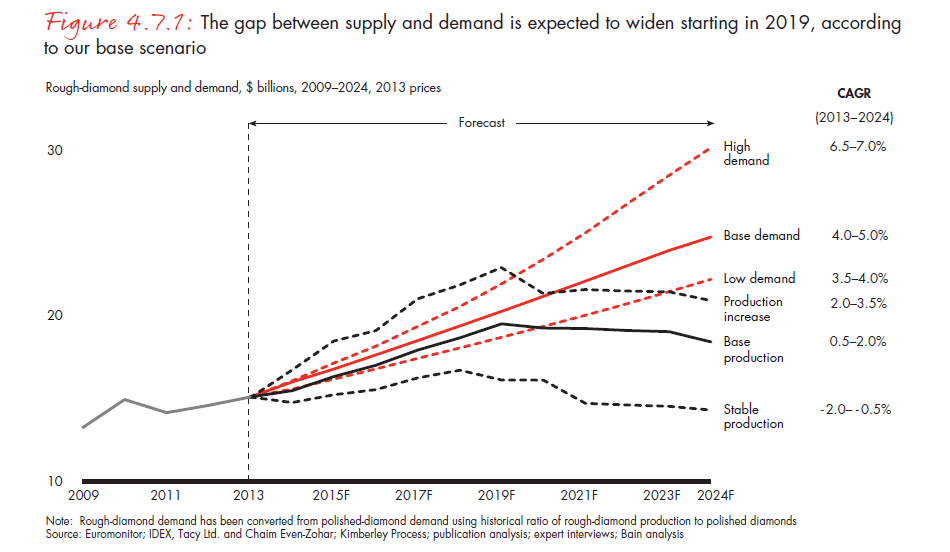
4.8 Risks and disruptive factors
We expect that factors analyzed in our 2013 forecast will continue to influence the global rough-diamond supply-demand balance over the coming decade. Some of the risks examined in last year’s report, such as uncertainty in the economic outlook, have materialized. Nevertheless, we see strong fundamentals in place in each market that could spur robust demand growth.
As in previous years, we believe that the odds of different risks and disruptions materializing will vary, as will their potential impacts. In developing their analyses and strategic plans, industry players and potential investors should therefore give serious consideration to such factors and carefully consider the impact of different scenarios on their plans.
First, uncertainty could still define the macroeconomic outlook. This year, we saw recovery in the US economy and slight improvement in the European economies. However, the nature of economic stagnation in Europe appears to be shifting from cyclical to structural. Moreover, the Asian countries, led by China and India, need to demonstrate the expected GDP and middle-class growth and prove that such growth will continue to translate into higher demand for diamonds.
A second factor that merits consideration is the potential development of a significant investment market for diamonds. Materialization of such a market would enhance overall demand. If demand exceeds supply even more than expected, demand for diamonds will rise; consequently, diamond prices will rise as well. Still, we believe that the investment market for diamonds remains in an early stage of development, although the space continues to interest potential investors.
Third, synthetic diamonds could negatively affect diamond demand. As discussed in Chapter 2, there is no evidence yet that, in the short run, synthetic diamonds will replace natural diamonds for use in jewelry. On the other hand, undisclosed synthetic stones could penetrate the supply pipeline despite industry players’ best efforts. Left unmanaged, such penetration could undermine consumers’ trust in natural diamonds.
Fourth, a significant increase in recycling of diamond jewelry could shape perceptions among consumers that they do not need to buy new polished diamonds. That could drive down demand for rough diamonds. In the long run, this effect can be mitigated if a growing market for recycled diamonds spurs investment demand by adding liquidity to the market.
We believe that developments related to synthetic diamonds and diamond jewelry recycling present a relatively low risk for industry players and can be properly managed by the industry
4.9 Key takeaways
- Global long-term rough-diamond demand is expected to continue its robust growth at 4–5% per year from 2013 through 2024, driven by strong fundamental economics such as overall wealth and middle-class growth in developing countries.
- China, India, and the US will continue to drive diamond consumption and will account for the lion’s share of new demand for diamond jewelry.
- The global supply volume of rough diamonds is expected to grow by a compound annual rate of 3.8% until 2019 and then decline by 1.8% from 2019 through 2024. This long-term decline in supply will stem from the aging of existing mines and the limited number of new projects coming online. Global long-term rough-diamond supply value is expected to grow at an annual rate of 0.5–2% until 2024.
- Bain & Company’s 2014 forecast projects that from 2014 through 2018, the demand growth rate is expected to exceed that of supply. Starting in 2019, we expect, the difference between the growth rates will widen by up to 6 percentage points. Demand is projected to continue its long-term growth trajectory, supported by the outlook for strong market and economic fundamentals, and supply is projected in line with the reduction in global production levels.
- Several factors could disrupt the diamond supply-demand balance. In particular, uncertainties about Europe’s economic recovery, increased political instability in Asian countries, and slowing economic growth in China and India could erode demand for diamonds. Companies crafting long-term strategic plans should carefully consider not only the base scenario offered here but also the Production Increase Scenario and the Stable Production Scenario.
Conclusion
In the preceding pages, we have taken a detailed and comprehensive look at the state of the global diamond market in 2013. We have analyzed the key challenges facing the industry, closely examined diamond financing, and presented the ten-year outlook for supply and demand. Through this undertaking, we have arrived at several key conclusions:
- Despite the positive market in 2013, there is increasing uncertainty in the macroeconomic landscape. In 2013, the diamond industry showed steady growth of 2–4% across every link in the value chain, powered mainly by demand in the US and China. India and China solidified their roles as leading centers for cutting and polishing and jewelry manufacturing, respectively. Meanwhile, concentration in the production segment of the value chain intensified, with the top five players accounting for 70% of volume and 85% of revenues. Their profitability also grew. The uncertainties facing the industry center on the macroeconomic environment, with two key questions standing out: Will China and the US sustain their robust GDP growth, and will revived GDP growth in India translate into higher demand for diamonds?
- The industry is exploring new ways to sustain the demand for diamonds in jewelry and as investments. Demand for diamond jewelry is still the main engine of diamond demand, accounting for 95% of the total. Historically sustained by De Beers’ generic marketing, jewelry marketing shifted to retailer-supported branded advertising beginning in 2000. Recent developments include closer cooperation among producers and retailers on specific types of stones and a sharper focus on emerging markets. Investment demand remains at a lower level, accounting for about 5% of total demand, despite diamonds’ attractiveness as an investment because of their low volatility and stable returns. The main constraints on diamond investing include the difficulty of appraising their value, the lack of price transparency, and limited market liquidity. The industry is supporting multiple initiatives aimed at fostering the long-term growth of investment demand.
- Retailers and jewelry manufacturers are increasing integration and cooperation with middle-market and upstream players to secure access to gem-quality stones. Because diamond demand is expected to outpace supply, securing long-term access to an assortment of stones will be critical for major retailers. To secure access, retailers are exploring long-term contractual agreements and investments in upstream or midstream players.
- Synthetic diamonds represent an opportunity for their technological and industrial applications; in jewelry, they can coexist with natural gems but can undermine consumer confidence if undisclosed. Synthetics create new opportunities in high-tech and industrial applications, with demand expected to grow 7% year-on-year through 2020. Moreover, they can coexist with natural stones as jewelry inputs. There is no indication that consumer preferences are shifting from natural diamonds to synthetics, but synthetics can erode customer confidence if sold undisclosed. The two major industry initiatives aimed at mitigating this risk are the increased use of synthetics detection technologies and more frequent certification.
- The diamond-financing business needs to adjust its operating model. Financing provided by diamond banks has played a vital role in sustaining the industry’s growth during the past decade. In the past few years, however, middle-market players have struggled to gain access to liquidity, owing to conditions arising in both the diamond and the banking industries. A new operating model for diamond financing is needed, built on four pillars: transparency of industry operations, involvement of up- and downstream players to support the middle market, development of new and more secure financing products, and attraction of new banking players to the industry.
- The long-term projection is for demand growth to surpass supply growth. We expect the difference between the demand and the supply growth rates to be positive from 2014 through 2018 and to widen by up to 6 percentage points starting in 2019. Demand is projected to continue its long-term growth trajectory, supported by the outlook for strong market and economic fundamentals, and supply is projected to develop in line with the reduction in global production levels.
This report was prepared by Olya Linde and Roberto De Meo from Bain & Company, together with Ari Epstein and Stephane Fischler from AWDC. The authors were supported by a global team, including Yury Glazkov, Anton Khabursky, Boris Kaminsky, Anton Matalygin, Masha Shiroyan, and Bain’s Mining and Luxury Goods practices.





























































